Management The Gender Pay Inequity
VerifiedAdded on 2021/05/30
|19
|4003
|254
AI Summary
Contribute Materials
Your contribution can guide someone’s learning journey. Share your
documents today.
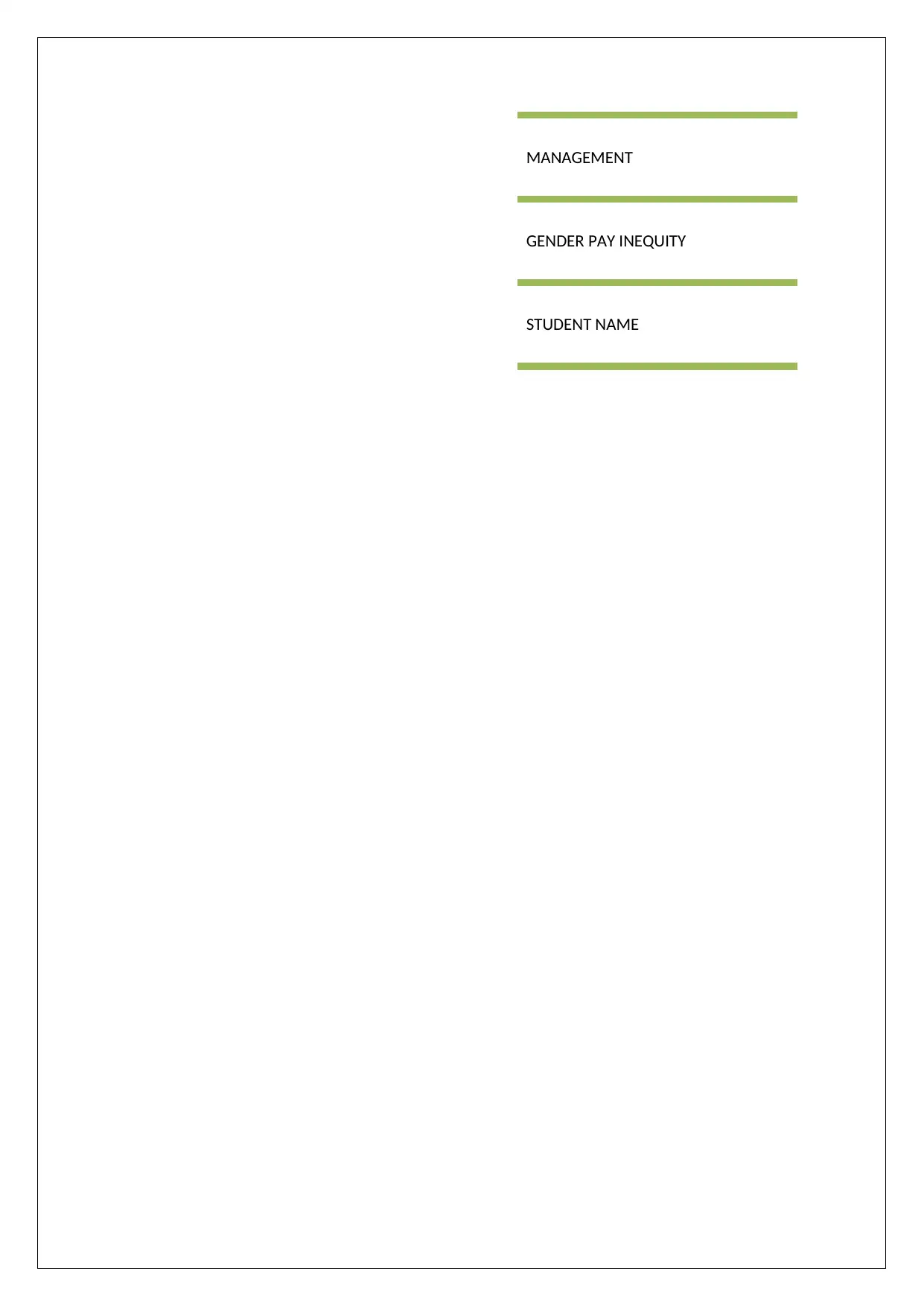
MANAGEMENT
GENDER PAY INEQUITY
STUDENT NAME
GENDER PAY INEQUITY
STUDENT NAME
Secure Best Marks with AI Grader
Need help grading? Try our AI Grader for instant feedback on your assignments.
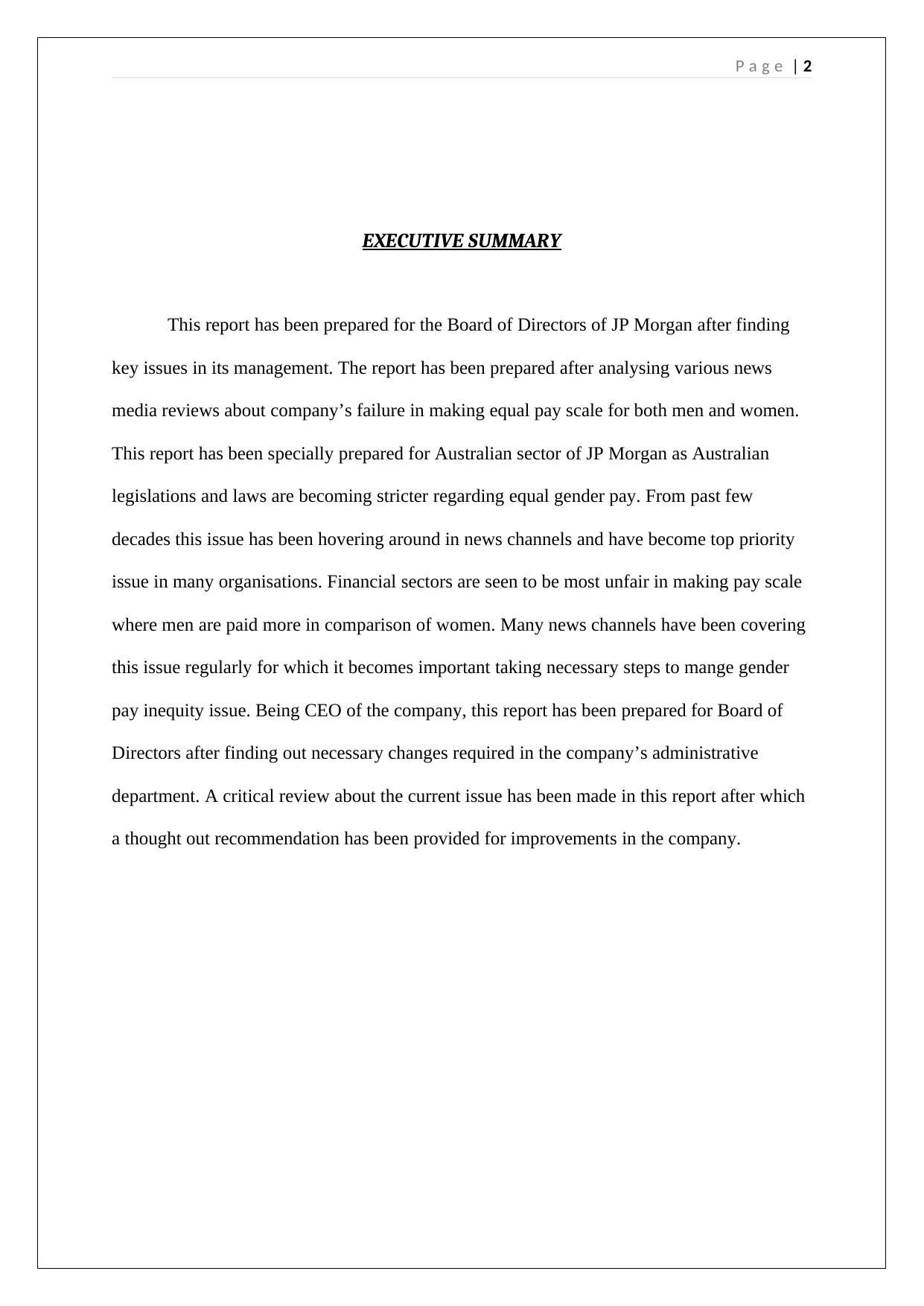
P a g e | 2
EXECUTIVE SUMMARY
This report has been prepared for the Board of Directors of JP Morgan after finding
key issues in its management. The report has been prepared after analysing various news
media reviews about company’s failure in making equal pay scale for both men and women.
This report has been specially prepared for Australian sector of JP Morgan as Australian
legislations and laws are becoming stricter regarding equal gender pay. From past few
decades this issue has been hovering around in news channels and have become top priority
issue in many organisations. Financial sectors are seen to be most unfair in making pay scale
where men are paid more in comparison of women. Many news channels have been covering
this issue regularly for which it becomes important taking necessary steps to mange gender
pay inequity issue. Being CEO of the company, this report has been prepared for Board of
Directors after finding out necessary changes required in the company’s administrative
department. A critical review about the current issue has been made in this report after which
a thought out recommendation has been provided for improvements in the company.
EXECUTIVE SUMMARY
This report has been prepared for the Board of Directors of JP Morgan after finding
key issues in its management. The report has been prepared after analysing various news
media reviews about company’s failure in making equal pay scale for both men and women.
This report has been specially prepared for Australian sector of JP Morgan as Australian
legislations and laws are becoming stricter regarding equal gender pay. From past few
decades this issue has been hovering around in news channels and have become top priority
issue in many organisations. Financial sectors are seen to be most unfair in making pay scale
where men are paid more in comparison of women. Many news channels have been covering
this issue regularly for which it becomes important taking necessary steps to mange gender
pay inequity issue. Being CEO of the company, this report has been prepared for Board of
Directors after finding out necessary changes required in the company’s administrative
department. A critical review about the current issue has been made in this report after which
a thought out recommendation has been provided for improvements in the company.
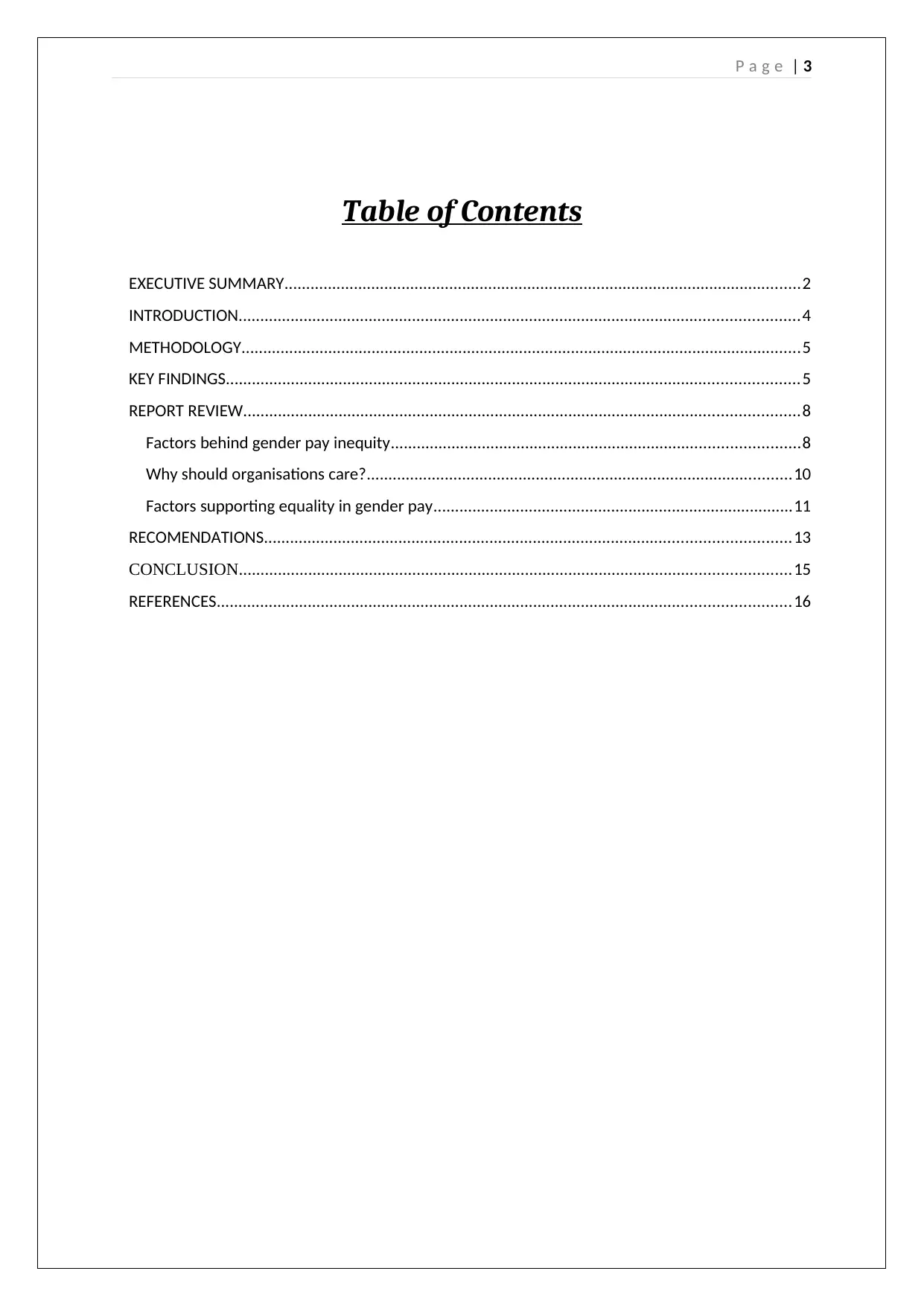
P a g e | 3
Table of Contents
EXECUTIVE SUMMARY.......................................................................................................................2
INTRODUCTION.................................................................................................................................4
METHODOLOGY.................................................................................................................................5
KEY FINDINGS....................................................................................................................................5
REPORT REVIEW................................................................................................................................8
Factors behind gender pay inequity..............................................................................................8
Why should organisations care?..................................................................................................10
Factors supporting equality in gender pay...................................................................................11
RECOMENDATIONS.........................................................................................................................13
CONCLUSION...............................................................................................................................15
REFERENCES....................................................................................................................................16
Table of Contents
EXECUTIVE SUMMARY.......................................................................................................................2
INTRODUCTION.................................................................................................................................4
METHODOLOGY.................................................................................................................................5
KEY FINDINGS....................................................................................................................................5
REPORT REVIEW................................................................................................................................8
Factors behind gender pay inequity..............................................................................................8
Why should organisations care?..................................................................................................10
Factors supporting equality in gender pay...................................................................................11
RECOMENDATIONS.........................................................................................................................13
CONCLUSION...............................................................................................................................15
REFERENCES....................................................................................................................................16
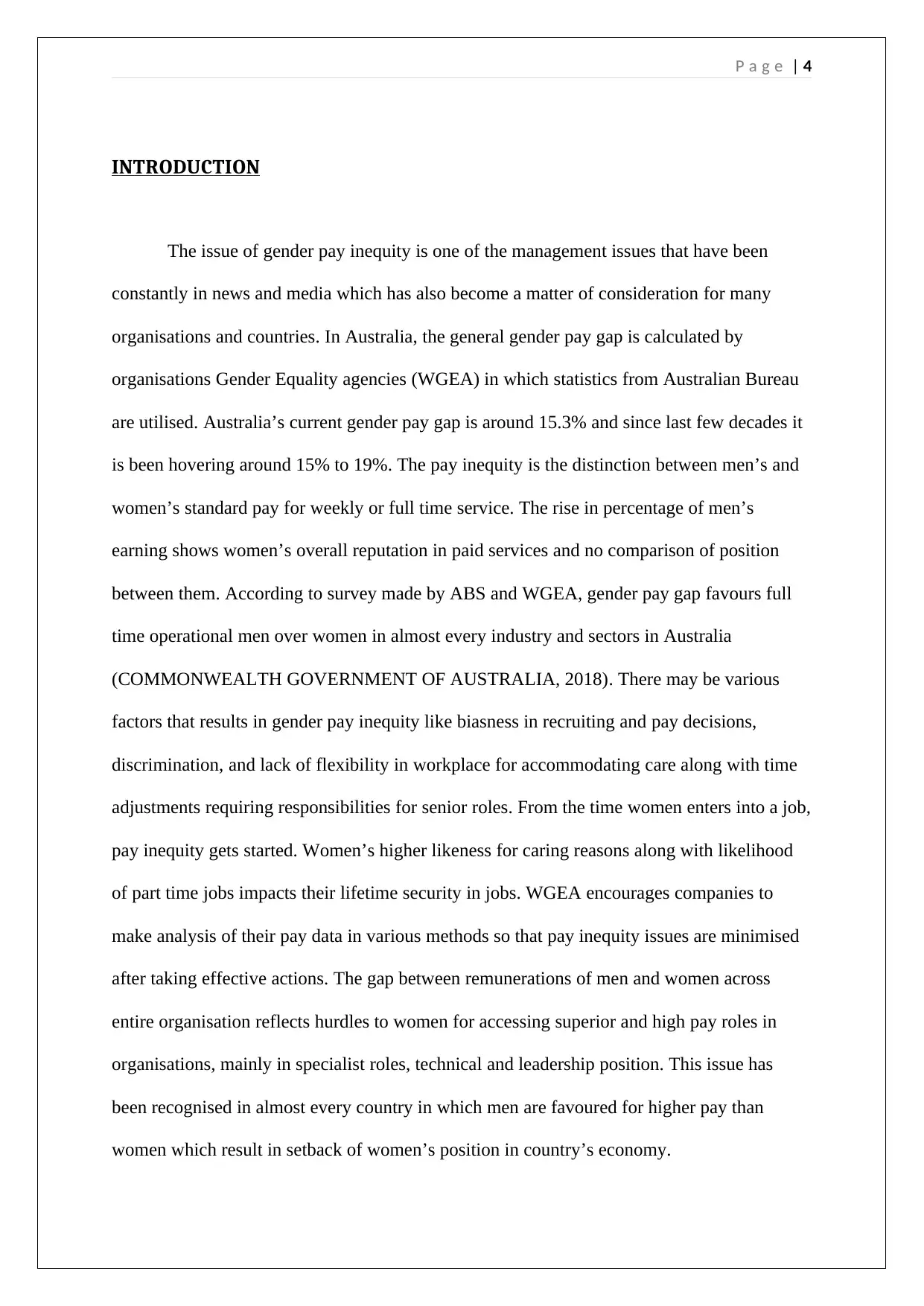
P a g e | 4
INTRODUCTION
The issue of gender pay inequity is one of the management issues that have been
constantly in news and media which has also become a matter of consideration for many
organisations and countries. In Australia, the general gender pay gap is calculated by
organisations Gender Equality agencies (WGEA) in which statistics from Australian Bureau
are utilised. Australia’s current gender pay gap is around 15.3% and since last few decades it
is been hovering around 15% to 19%. The pay inequity is the distinction between men’s and
women’s standard pay for weekly or full time service. The rise in percentage of men’s
earning shows women’s overall reputation in paid services and no comparison of position
between them. According to survey made by ABS and WGEA, gender pay gap favours full
time operational men over women in almost every industry and sectors in Australia
(COMMONWEALTH GOVERNMENT OF AUSTRALIA, 2018). There may be various
factors that results in gender pay inequity like biasness in recruiting and pay decisions,
discrimination, and lack of flexibility in workplace for accommodating care along with time
adjustments requiring responsibilities for senior roles. From the time women enters into a job,
pay inequity gets started. Women’s higher likeness for caring reasons along with likelihood
of part time jobs impacts their lifetime security in jobs. WGEA encourages companies to
make analysis of their pay data in various methods so that pay inequity issues are minimised
after taking effective actions. The gap between remunerations of men and women across
entire organisation reflects hurdles to women for accessing superior and high pay roles in
organisations, mainly in specialist roles, technical and leadership position. This issue has
been recognised in almost every country in which men are favoured for higher pay than
women which result in setback of women’s position in country’s economy.
INTRODUCTION
The issue of gender pay inequity is one of the management issues that have been
constantly in news and media which has also become a matter of consideration for many
organisations and countries. In Australia, the general gender pay gap is calculated by
organisations Gender Equality agencies (WGEA) in which statistics from Australian Bureau
are utilised. Australia’s current gender pay gap is around 15.3% and since last few decades it
is been hovering around 15% to 19%. The pay inequity is the distinction between men’s and
women’s standard pay for weekly or full time service. The rise in percentage of men’s
earning shows women’s overall reputation in paid services and no comparison of position
between them. According to survey made by ABS and WGEA, gender pay gap favours full
time operational men over women in almost every industry and sectors in Australia
(COMMONWEALTH GOVERNMENT OF AUSTRALIA, 2018). There may be various
factors that results in gender pay inequity like biasness in recruiting and pay decisions,
discrimination, and lack of flexibility in workplace for accommodating care along with time
adjustments requiring responsibilities for senior roles. From the time women enters into a job,
pay inequity gets started. Women’s higher likeness for caring reasons along with likelihood
of part time jobs impacts their lifetime security in jobs. WGEA encourages companies to
make analysis of their pay data in various methods so that pay inequity issues are minimised
after taking effective actions. The gap between remunerations of men and women across
entire organisation reflects hurdles to women for accessing superior and high pay roles in
organisations, mainly in specialist roles, technical and leadership position. This issue has
been recognised in almost every country in which men are favoured for higher pay than
women which result in setback of women’s position in country’s economy.
Secure Best Marks with AI Grader
Need help grading? Try our AI Grader for instant feedback on your assignments.
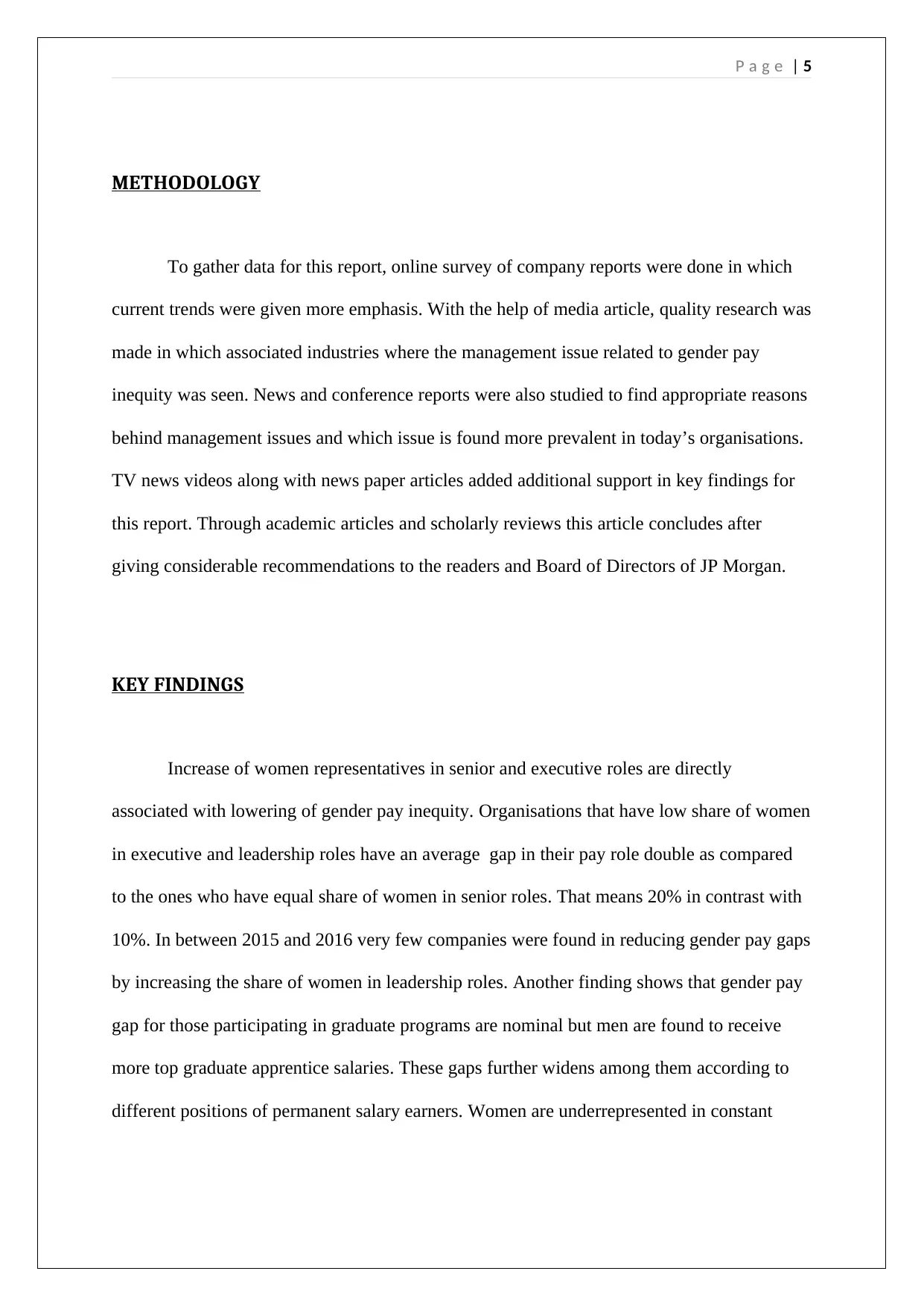
P a g e | 5
METHODOLOGY
To gather data for this report, online survey of company reports were done in which
current trends were given more emphasis. With the help of media article, quality research was
made in which associated industries where the management issue related to gender pay
inequity was seen. News and conference reports were also studied to find appropriate reasons
behind management issues and which issue is found more prevalent in today’s organisations.
TV news videos along with news paper articles added additional support in key findings for
this report. Through academic articles and scholarly reviews this article concludes after
giving considerable recommendations to the readers and Board of Directors of JP Morgan.
KEY FINDINGS
Increase of women representatives in senior and executive roles are directly
associated with lowering of gender pay inequity. Organisations that have low share of women
in executive and leadership roles have an average gap in their pay role double as compared
to the ones who have equal share of women in senior roles. That means 20% in contrast with
10%. In between 2015 and 2016 very few companies were found in reducing gender pay gaps
by increasing the share of women in leadership roles. Another finding shows that gender pay
gap for those participating in graduate programs are nominal but men are found to receive
more top graduate apprentice salaries. These gaps further widens among them according to
different positions of permanent salary earners. Women are underrepresented in constant
METHODOLOGY
To gather data for this report, online survey of company reports were done in which
current trends were given more emphasis. With the help of media article, quality research was
made in which associated industries where the management issue related to gender pay
inequity was seen. News and conference reports were also studied to find appropriate reasons
behind management issues and which issue is found more prevalent in today’s organisations.
TV news videos along with news paper articles added additional support in key findings for
this report. Through academic articles and scholarly reviews this article concludes after
giving considerable recommendations to the readers and Board of Directors of JP Morgan.
KEY FINDINGS
Increase of women representatives in senior and executive roles are directly
associated with lowering of gender pay inequity. Organisations that have low share of women
in executive and leadership roles have an average gap in their pay role double as compared
to the ones who have equal share of women in senior roles. That means 20% in contrast with
10%. In between 2015 and 2016 very few companies were found in reducing gender pay gaps
by increasing the share of women in leadership roles. Another finding shows that gender pay
gap for those participating in graduate programs are nominal but men are found to receive
more top graduate apprentice salaries. These gaps further widens among them according to
different positions of permanent salary earners. Women are underrepresented in constant
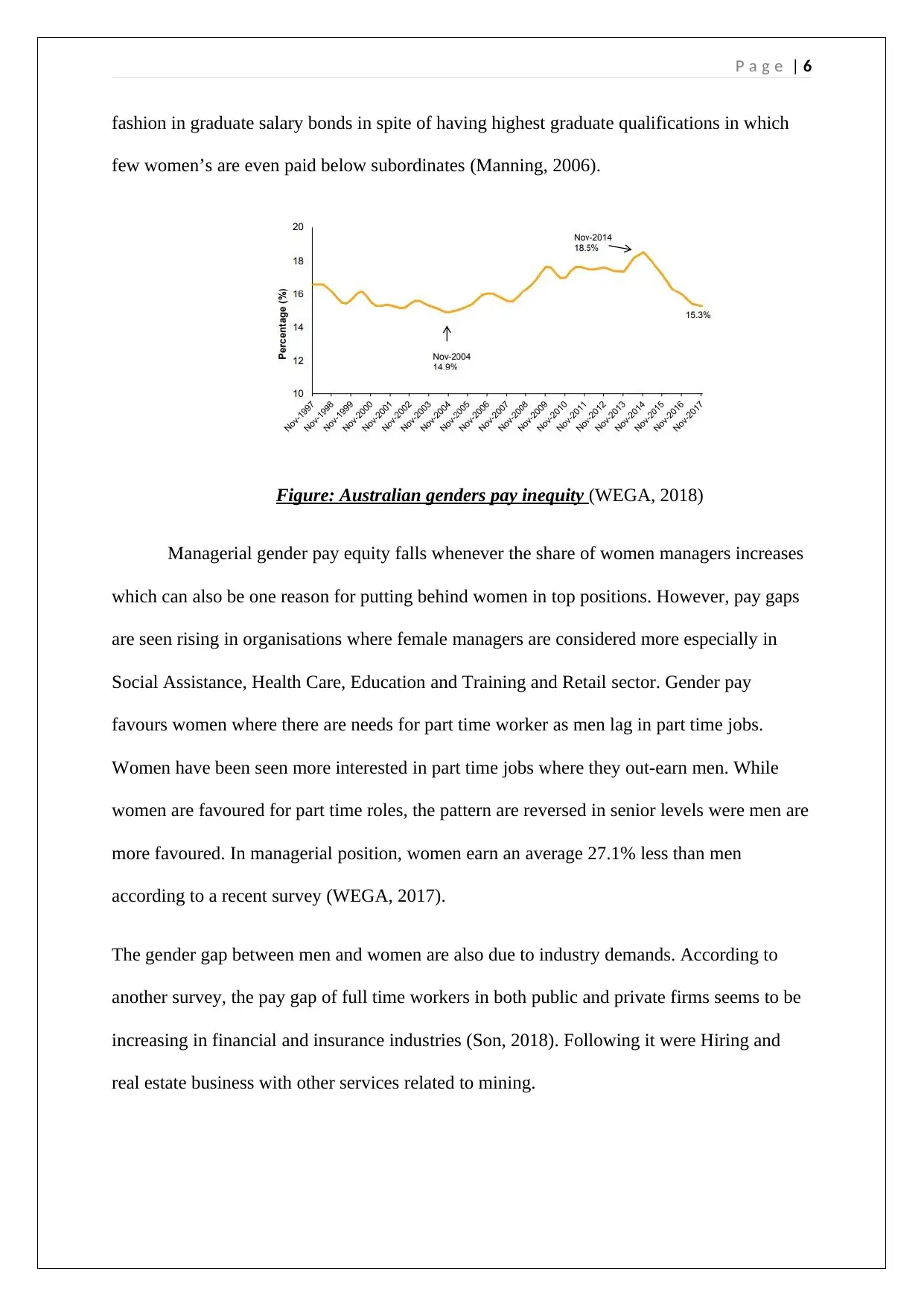
P a g e | 6
fashion in graduate salary bonds in spite of having highest graduate qualifications in which
few women’s are even paid below subordinates (Manning, 2006).
Figure: Australian genders pay inequity (WEGA, 2018)
Managerial gender pay equity falls whenever the share of women managers increases
which can also be one reason for putting behind women in top positions. However, pay gaps
are seen rising in organisations where female managers are considered more especially in
Social Assistance, Health Care, Education and Training and Retail sector. Gender pay
favours women where there are needs for part time worker as men lag in part time jobs.
Women have been seen more interested in part time jobs where they out-earn men. While
women are favoured for part time roles, the pattern are reversed in senior levels were men are
more favoured. In managerial position, women earn an average 27.1% less than men
according to a recent survey (WEGA, 2017).
The gender gap between men and women are also due to industry demands. According to
another survey, the pay gap of full time workers in both public and private firms seems to be
increasing in financial and insurance industries (Son, 2018). Following it were Hiring and
real estate business with other services related to mining.
fashion in graduate salary bonds in spite of having highest graduate qualifications in which
few women’s are even paid below subordinates (Manning, 2006).
Figure: Australian genders pay inequity (WEGA, 2018)
Managerial gender pay equity falls whenever the share of women managers increases
which can also be one reason for putting behind women in top positions. However, pay gaps
are seen rising in organisations where female managers are considered more especially in
Social Assistance, Health Care, Education and Training and Retail sector. Gender pay
favours women where there are needs for part time worker as men lag in part time jobs.
Women have been seen more interested in part time jobs where they out-earn men. While
women are favoured for part time roles, the pattern are reversed in senior levels were men are
more favoured. In managerial position, women earn an average 27.1% less than men
according to a recent survey (WEGA, 2017).
The gender gap between men and women are also due to industry demands. According to
another survey, the pay gap of full time workers in both public and private firms seems to be
increasing in financial and insurance industries (Son, 2018). Following it were Hiring and
real estate business with other services related to mining.
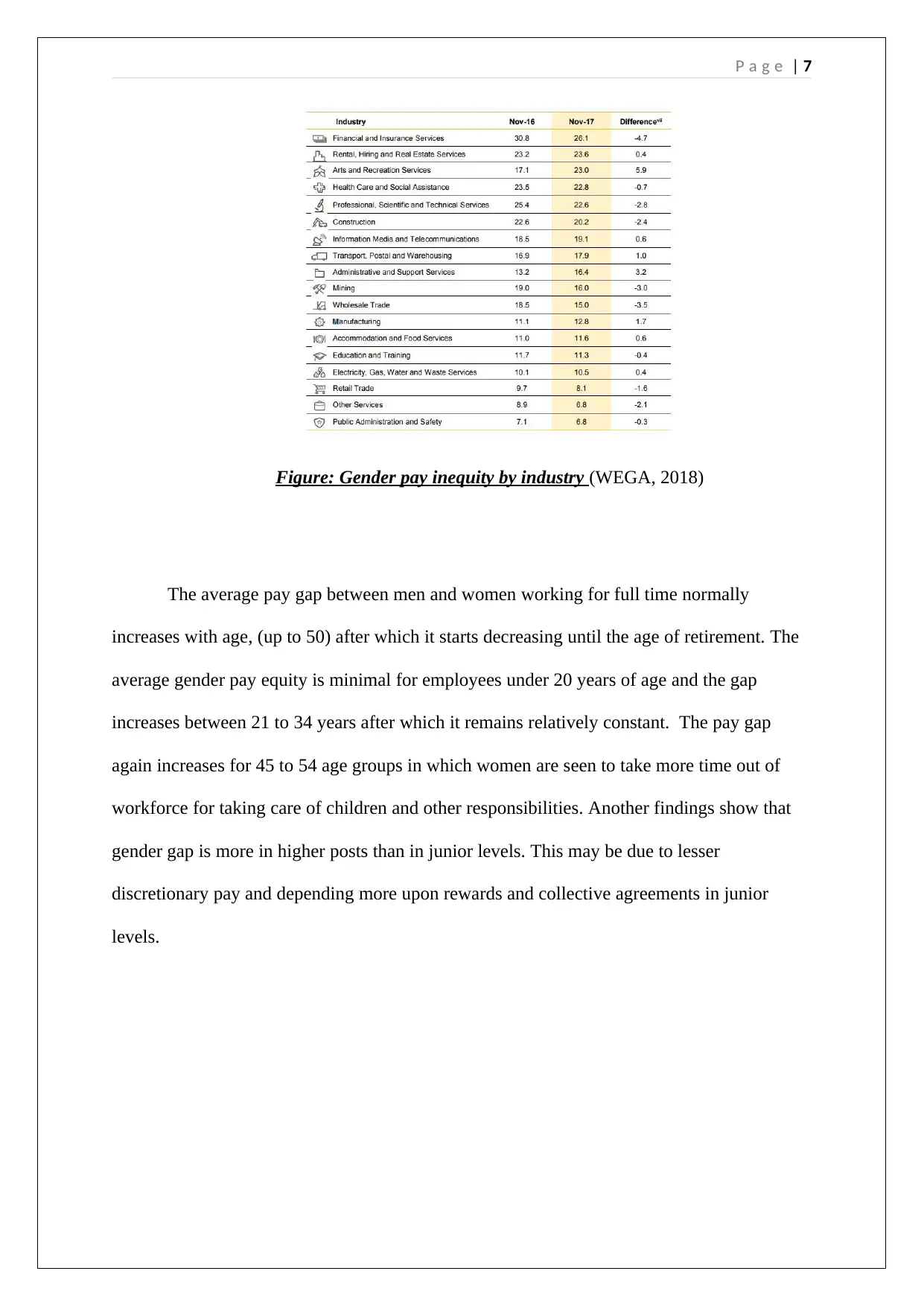
P a g e | 7
Figure: Gender pay inequity by industry (WEGA, 2018)
The average pay gap between men and women working for full time normally
increases with age, (up to 50) after which it starts decreasing until the age of retirement. The
average gender pay equity is minimal for employees under 20 years of age and the gap
increases between 21 to 34 years after which it remains relatively constant. The pay gap
again increases for 45 to 54 age groups in which women are seen to take more time out of
workforce for taking care of children and other responsibilities. Another findings show that
gender gap is more in higher posts than in junior levels. This may be due to lesser
discretionary pay and depending more upon rewards and collective agreements in junior
levels.
Figure: Gender pay inequity by industry (WEGA, 2018)
The average pay gap between men and women working for full time normally
increases with age, (up to 50) after which it starts decreasing until the age of retirement. The
average gender pay equity is minimal for employees under 20 years of age and the gap
increases between 21 to 34 years after which it remains relatively constant. The pay gap
again increases for 45 to 54 age groups in which women are seen to take more time out of
workforce for taking care of children and other responsibilities. Another findings show that
gender gap is more in higher posts than in junior levels. This may be due to lesser
discretionary pay and depending more upon rewards and collective agreements in junior
levels.
Paraphrase This Document
Need a fresh take? Get an instant paraphrase of this document with our AI Paraphraser
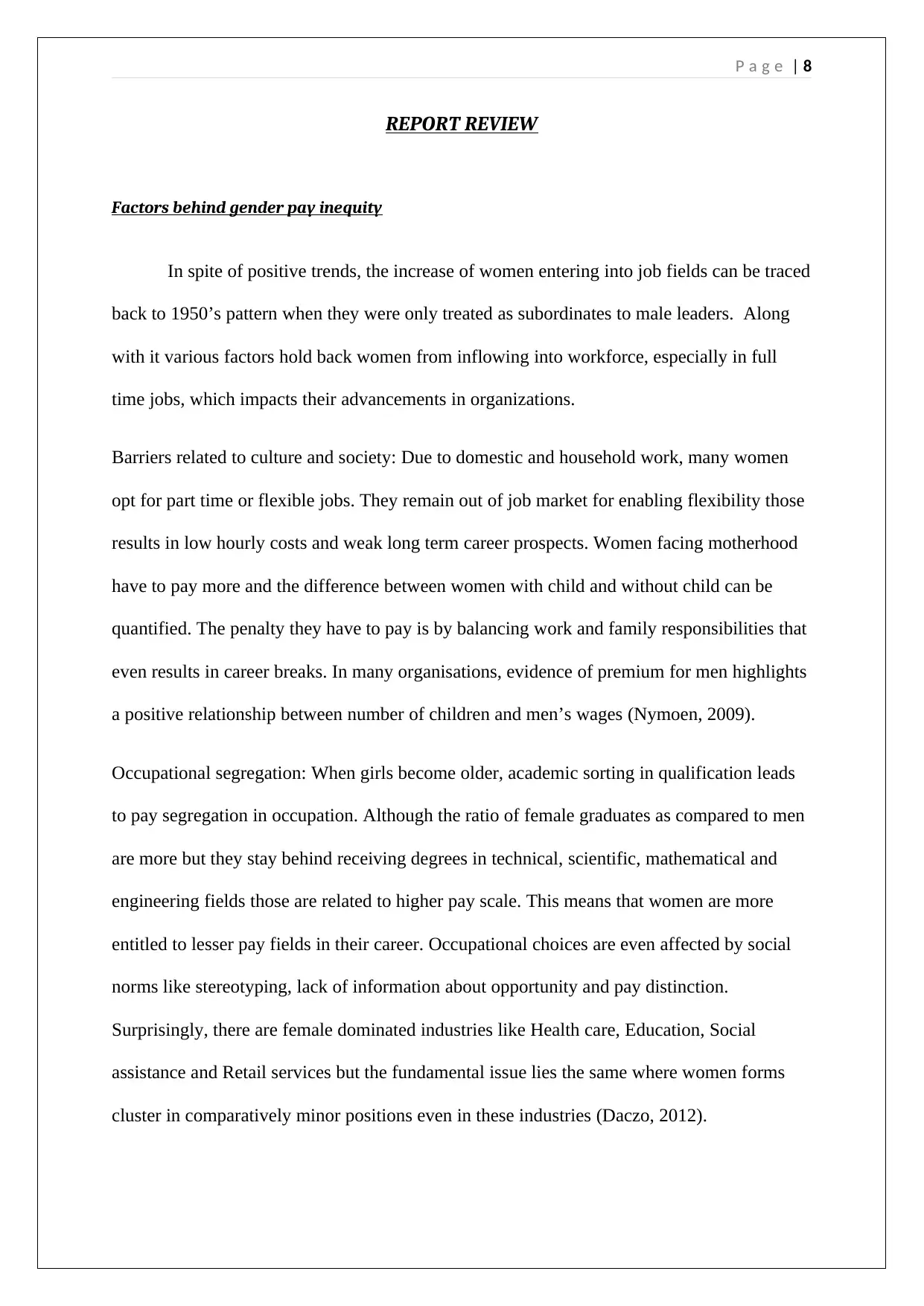
P a g e | 8
REPORT REVIEW
Factors behind gender pay inequity
In spite of positive trends, the increase of women entering into job fields can be traced
back to 1950’s pattern when they were only treated as subordinates to male leaders. Along
with it various factors hold back women from inflowing into workforce, especially in full
time jobs, which impacts their advancements in organizations.
Barriers related to culture and society: Due to domestic and household work, many women
opt for part time or flexible jobs. They remain out of job market for enabling flexibility those
results in low hourly costs and weak long term career prospects. Women facing motherhood
have to pay more and the difference between women with child and without child can be
quantified. The penalty they have to pay is by balancing work and family responsibilities that
even results in career breaks. In many organisations, evidence of premium for men highlights
a positive relationship between number of children and men’s wages (Nymoen, 2009).
Occupational segregation: When girls become older, academic sorting in qualification leads
to pay segregation in occupation. Although the ratio of female graduates as compared to men
are more but they stay behind receiving degrees in technical, scientific, mathematical and
engineering fields those are related to higher pay scale. This means that women are more
entitled to lesser pay fields in their career. Occupational choices are even affected by social
norms like stereotyping, lack of information about opportunity and pay distinction.
Surprisingly, there are female dominated industries like Health care, Education, Social
assistance and Retail services but the fundamental issue lies the same where women forms
cluster in comparatively minor positions even in these industries (Daczo, 2012).
REPORT REVIEW
Factors behind gender pay inequity
In spite of positive trends, the increase of women entering into job fields can be traced
back to 1950’s pattern when they were only treated as subordinates to male leaders. Along
with it various factors hold back women from inflowing into workforce, especially in full
time jobs, which impacts their advancements in organizations.
Barriers related to culture and society: Due to domestic and household work, many women
opt for part time or flexible jobs. They remain out of job market for enabling flexibility those
results in low hourly costs and weak long term career prospects. Women facing motherhood
have to pay more and the difference between women with child and without child can be
quantified. The penalty they have to pay is by balancing work and family responsibilities that
even results in career breaks. In many organisations, evidence of premium for men highlights
a positive relationship between number of children and men’s wages (Nymoen, 2009).
Occupational segregation: When girls become older, academic sorting in qualification leads
to pay segregation in occupation. Although the ratio of female graduates as compared to men
are more but they stay behind receiving degrees in technical, scientific, mathematical and
engineering fields those are related to higher pay scale. This means that women are more
entitled to lesser pay fields in their career. Occupational choices are even affected by social
norms like stereotyping, lack of information about opportunity and pay distinction.
Surprisingly, there are female dominated industries like Health care, Education, Social
assistance and Retail services but the fundamental issue lies the same where women forms
cluster in comparatively minor positions even in these industries (Daczo, 2012).
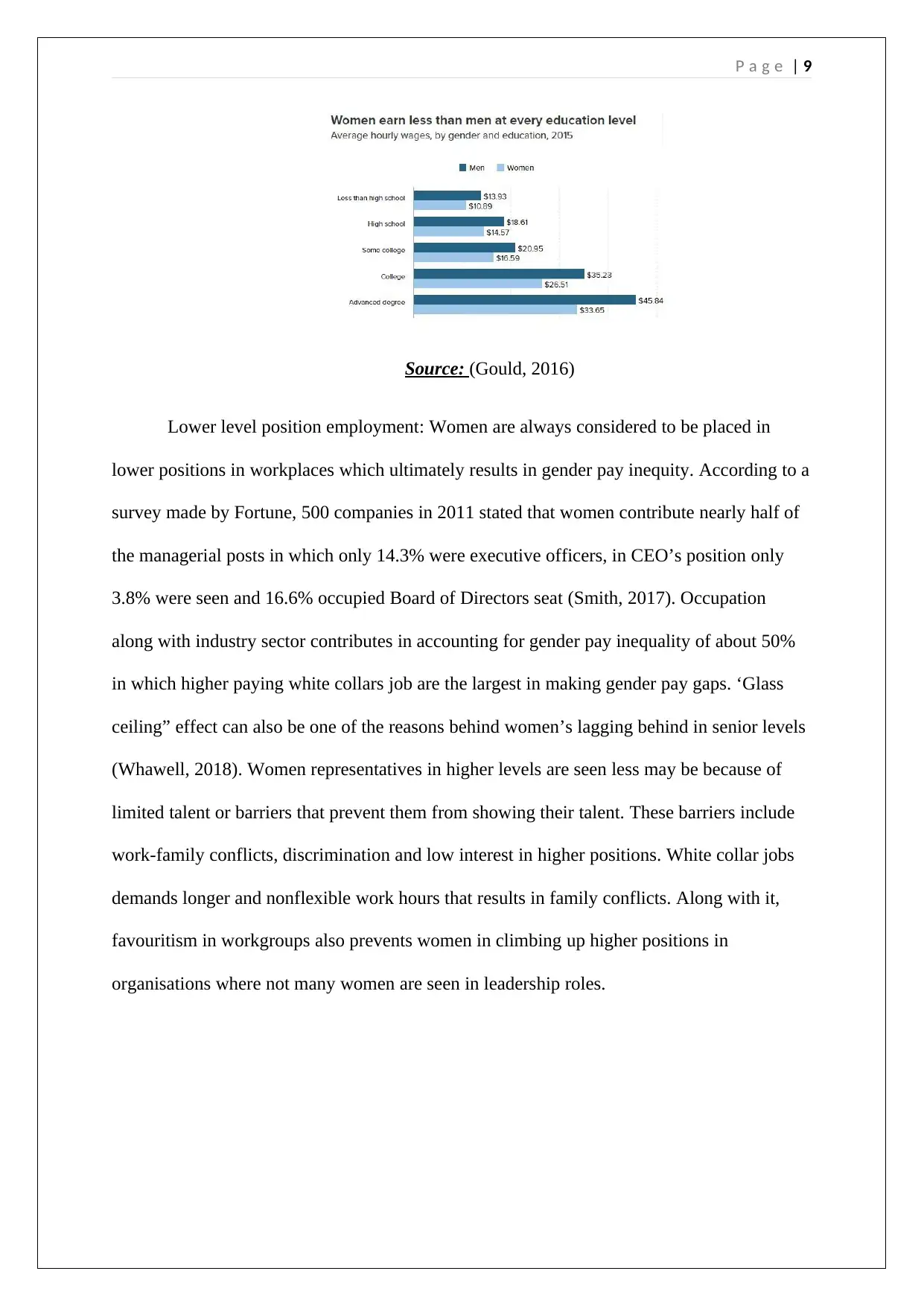
P a g e | 9
Source: (Gould, 2016)
Lower level position employment: Women are always considered to be placed in
lower positions in workplaces which ultimately results in gender pay inequity. According to a
survey made by Fortune, 500 companies in 2011 stated that women contribute nearly half of
the managerial posts in which only 14.3% were executive officers, in CEO’s position only
3.8% were seen and 16.6% occupied Board of Directors seat (Smith, 2017). Occupation
along with industry sector contributes in accounting for gender pay inequality of about 50%
in which higher paying white collars job are the largest in making gender pay gaps. ‘Glass
ceiling” effect can also be one of the reasons behind women’s lagging behind in senior levels
(Whawell, 2018). Women representatives in higher levels are seen less may be because of
limited talent or barriers that prevent them from showing their talent. These barriers include
work-family conflicts, discrimination and low interest in higher positions. White collar jobs
demands longer and nonflexible work hours that results in family conflicts. Along with it,
favouritism in workgroups also prevents women in climbing up higher positions in
organisations where not many women are seen in leadership roles.
Source: (Gould, 2016)
Lower level position employment: Women are always considered to be placed in
lower positions in workplaces which ultimately results in gender pay inequity. According to a
survey made by Fortune, 500 companies in 2011 stated that women contribute nearly half of
the managerial posts in which only 14.3% were executive officers, in CEO’s position only
3.8% were seen and 16.6% occupied Board of Directors seat (Smith, 2017). Occupation
along with industry sector contributes in accounting for gender pay inequality of about 50%
in which higher paying white collars job are the largest in making gender pay gaps. ‘Glass
ceiling” effect can also be one of the reasons behind women’s lagging behind in senior levels
(Whawell, 2018). Women representatives in higher levels are seen less may be because of
limited talent or barriers that prevent them from showing their talent. These barriers include
work-family conflicts, discrimination and low interest in higher positions. White collar jobs
demands longer and nonflexible work hours that results in family conflicts. Along with it,
favouritism in workgroups also prevents women in climbing up higher positions in
organisations where not many women are seen in leadership roles.
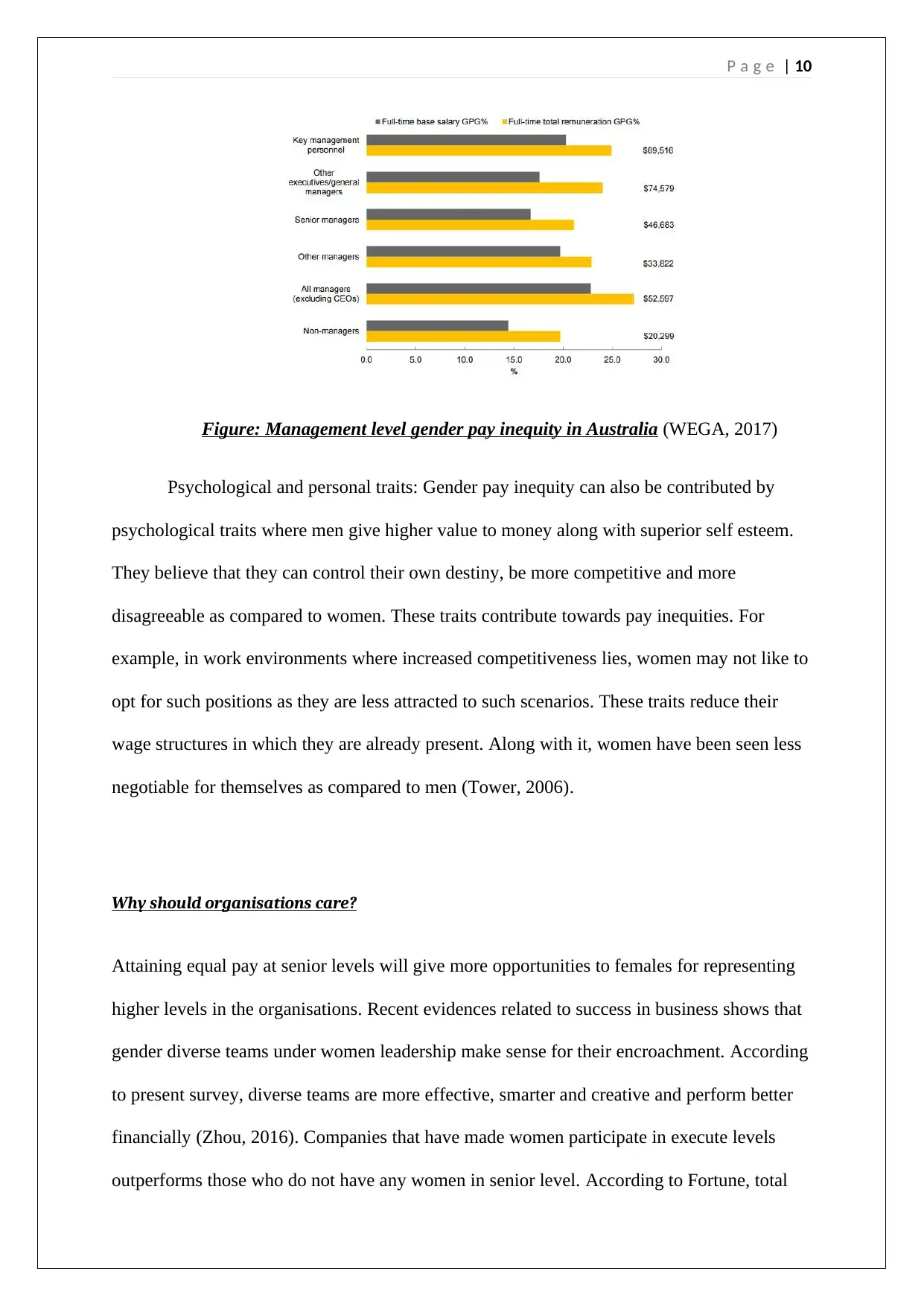
P a g e | 10
Figure: Management level gender pay inequity in Australia (WEGA, 2017)
Psychological and personal traits: Gender pay inequity can also be contributed by
psychological traits where men give higher value to money along with superior self esteem.
They believe that they can control their own destiny, be more competitive and more
disagreeable as compared to women. These traits contribute towards pay inequities. For
example, in work environments where increased competitiveness lies, women may not like to
opt for such positions as they are less attracted to such scenarios. These traits reduce their
wage structures in which they are already present. Along with it, women have been seen less
negotiable for themselves as compared to men (Tower, 2006).
Why should organisations care?
Attaining equal pay at senior levels will give more opportunities to females for representing
higher levels in the organisations. Recent evidences related to success in business shows that
gender diverse teams under women leadership make sense for their encroachment. According
to present survey, diverse teams are more effective, smarter and creative and perform better
financially (Zhou, 2016). Companies that have made women participate in execute levels
outperforms those who do not have any women in senior level. According to Fortune, total
Figure: Management level gender pay inequity in Australia (WEGA, 2017)
Psychological and personal traits: Gender pay inequity can also be contributed by
psychological traits where men give higher value to money along with superior self esteem.
They believe that they can control their own destiny, be more competitive and more
disagreeable as compared to women. These traits contribute towards pay inequities. For
example, in work environments where increased competitiveness lies, women may not like to
opt for such positions as they are less attracted to such scenarios. These traits reduce their
wage structures in which they are already present. Along with it, women have been seen less
negotiable for themselves as compared to men (Tower, 2006).
Why should organisations care?
Attaining equal pay at senior levels will give more opportunities to females for representing
higher levels in the organisations. Recent evidences related to success in business shows that
gender diverse teams under women leadership make sense for their encroachment. According
to present survey, diverse teams are more effective, smarter and creative and perform better
financially (Zhou, 2016). Companies that have made women participate in execute levels
outperforms those who do not have any women in senior level. According to Fortune, total
Secure Best Marks with AI Grader
Need help grading? Try our AI Grader for instant feedback on your assignments.
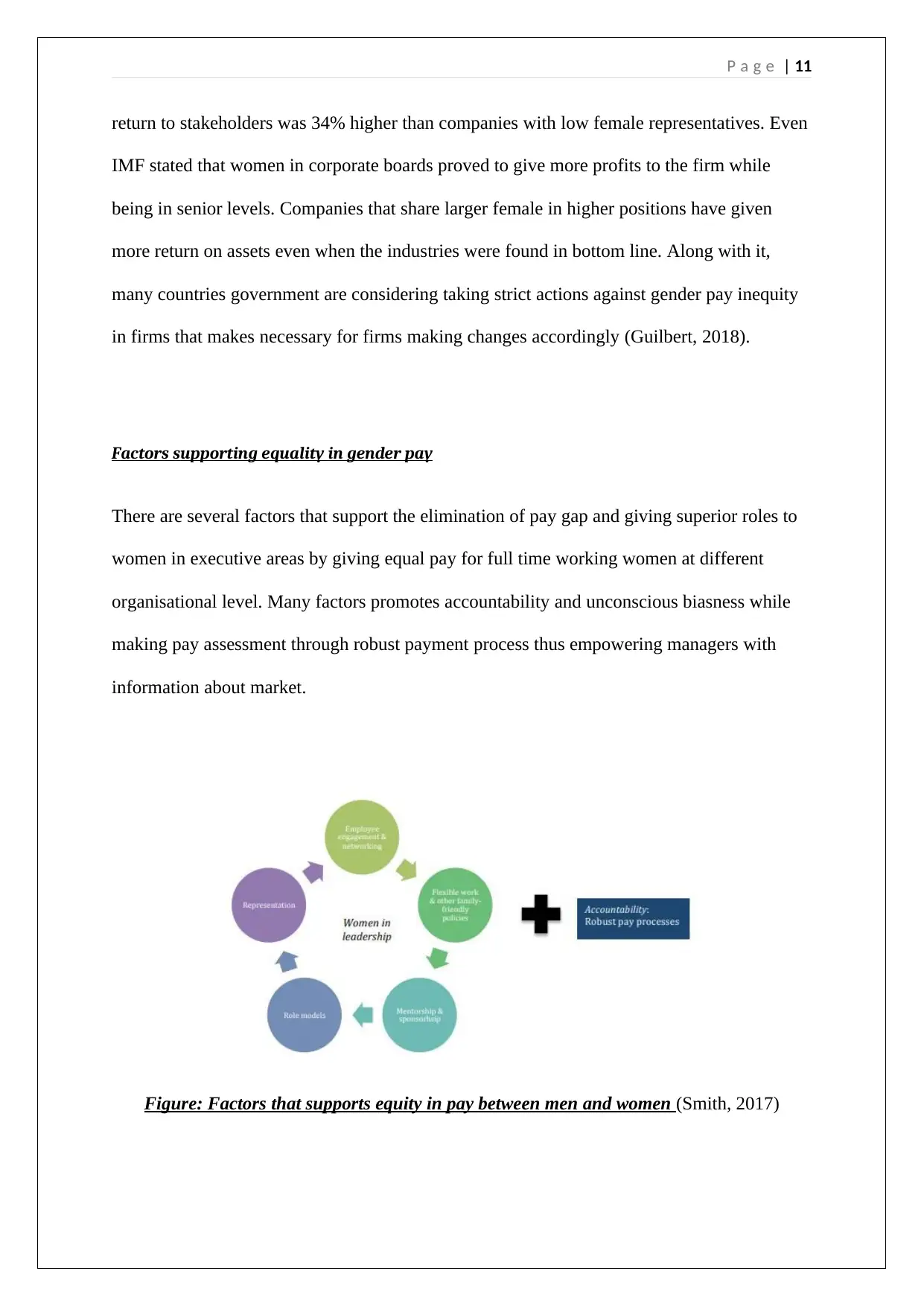
P a g e | 11
return to stakeholders was 34% higher than companies with low female representatives. Even
IMF stated that women in corporate boards proved to give more profits to the firm while
being in senior levels. Companies that share larger female in higher positions have given
more return on assets even when the industries were found in bottom line. Along with it,
many countries government are considering taking strict actions against gender pay inequity
in firms that makes necessary for firms making changes accordingly (Guilbert, 2018).
Factors supporting equality in gender pay
There are several factors that support the elimination of pay gap and giving superior roles to
women in executive areas by giving equal pay for full time working women at different
organisational level. Many factors promotes accountability and unconscious biasness while
making pay assessment through robust payment process thus empowering managers with
information about market.
Figure: Factors that supports equity in pay between men and women (Smith, 2017)
return to stakeholders was 34% higher than companies with low female representatives. Even
IMF stated that women in corporate boards proved to give more profits to the firm while
being in senior levels. Companies that share larger female in higher positions have given
more return on assets even when the industries were found in bottom line. Along with it,
many countries government are considering taking strict actions against gender pay inequity
in firms that makes necessary for firms making changes accordingly (Guilbert, 2018).
Factors supporting equality in gender pay
There are several factors that support the elimination of pay gap and giving superior roles to
women in executive areas by giving equal pay for full time working women at different
organisational level. Many factors promotes accountability and unconscious biasness while
making pay assessment through robust payment process thus empowering managers with
information about market.
Figure: Factors that supports equity in pay between men and women (Smith, 2017)
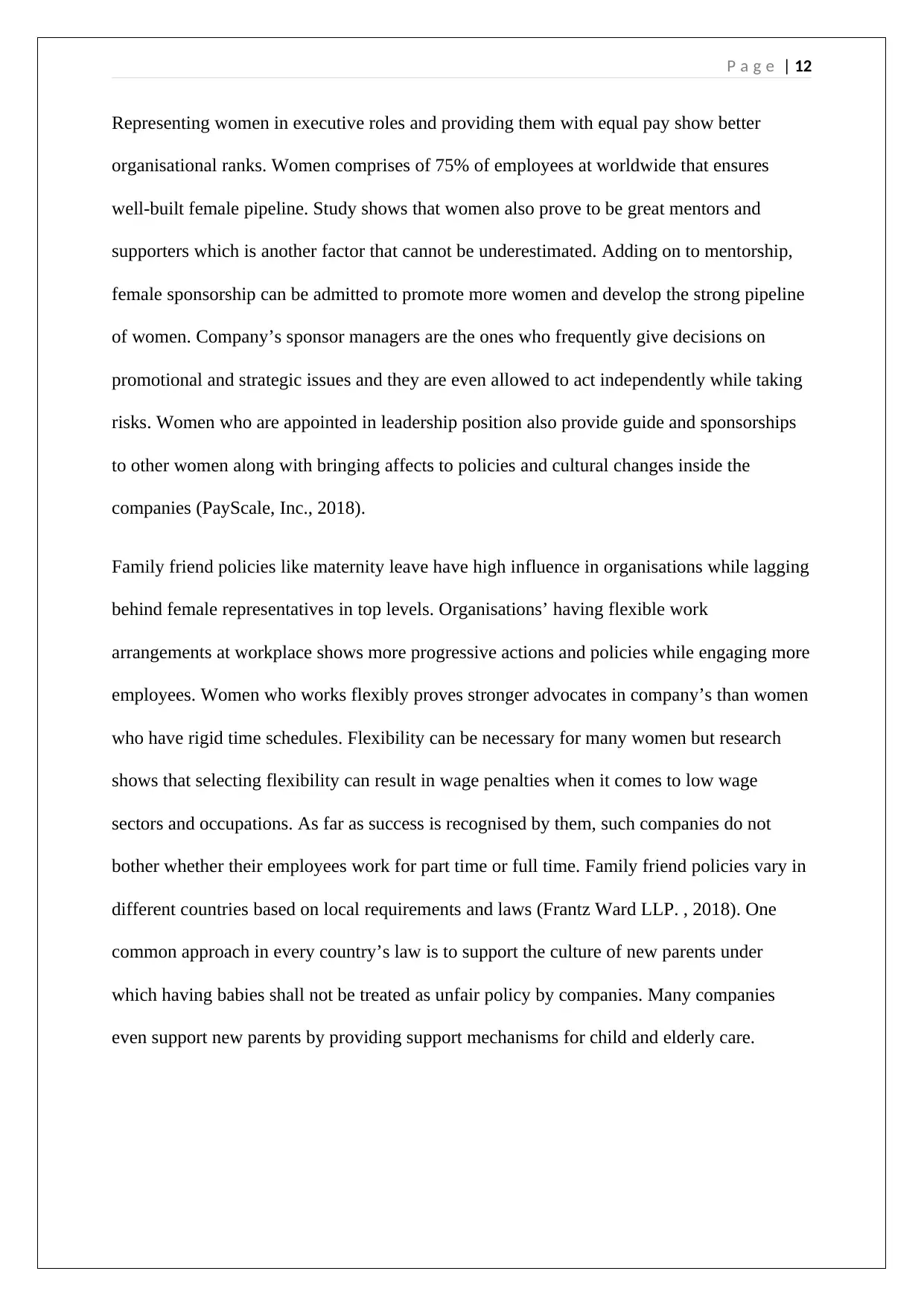
P a g e | 12
Representing women in executive roles and providing them with equal pay show better
organisational ranks. Women comprises of 75% of employees at worldwide that ensures
well-built female pipeline. Study shows that women also prove to be great mentors and
supporters which is another factor that cannot be underestimated. Adding on to mentorship,
female sponsorship can be admitted to promote more women and develop the strong pipeline
of women. Company’s sponsor managers are the ones who frequently give decisions on
promotional and strategic issues and they are even allowed to act independently while taking
risks. Women who are appointed in leadership position also provide guide and sponsorships
to other women along with bringing affects to policies and cultural changes inside the
companies (PayScale, Inc., 2018).
Family friend policies like maternity leave have high influence in organisations while lagging
behind female representatives in top levels. Organisations’ having flexible work
arrangements at workplace shows more progressive actions and policies while engaging more
employees. Women who works flexibly proves stronger advocates in company’s than women
who have rigid time schedules. Flexibility can be necessary for many women but research
shows that selecting flexibility can result in wage penalties when it comes to low wage
sectors and occupations. As far as success is recognised by them, such companies do not
bother whether their employees work for part time or full time. Family friend policies vary in
different countries based on local requirements and laws (Frantz Ward LLP. , 2018). One
common approach in every country’s law is to support the culture of new parents under
which having babies shall not be treated as unfair policy by companies. Many companies
even support new parents by providing support mechanisms for child and elderly care.
Representing women in executive roles and providing them with equal pay show better
organisational ranks. Women comprises of 75% of employees at worldwide that ensures
well-built female pipeline. Study shows that women also prove to be great mentors and
supporters which is another factor that cannot be underestimated. Adding on to mentorship,
female sponsorship can be admitted to promote more women and develop the strong pipeline
of women. Company’s sponsor managers are the ones who frequently give decisions on
promotional and strategic issues and they are even allowed to act independently while taking
risks. Women who are appointed in leadership position also provide guide and sponsorships
to other women along with bringing affects to policies and cultural changes inside the
companies (PayScale, Inc., 2018).
Family friend policies like maternity leave have high influence in organisations while lagging
behind female representatives in top levels. Organisations’ having flexible work
arrangements at workplace shows more progressive actions and policies while engaging more
employees. Women who works flexibly proves stronger advocates in company’s than women
who have rigid time schedules. Flexibility can be necessary for many women but research
shows that selecting flexibility can result in wage penalties when it comes to low wage
sectors and occupations. As far as success is recognised by them, such companies do not
bother whether their employees work for part time or full time. Family friend policies vary in
different countries based on local requirements and laws (Frantz Ward LLP. , 2018). One
common approach in every country’s law is to support the culture of new parents under
which having babies shall not be treated as unfair policy by companies. Many companies
even support new parents by providing support mechanisms for child and elderly care.
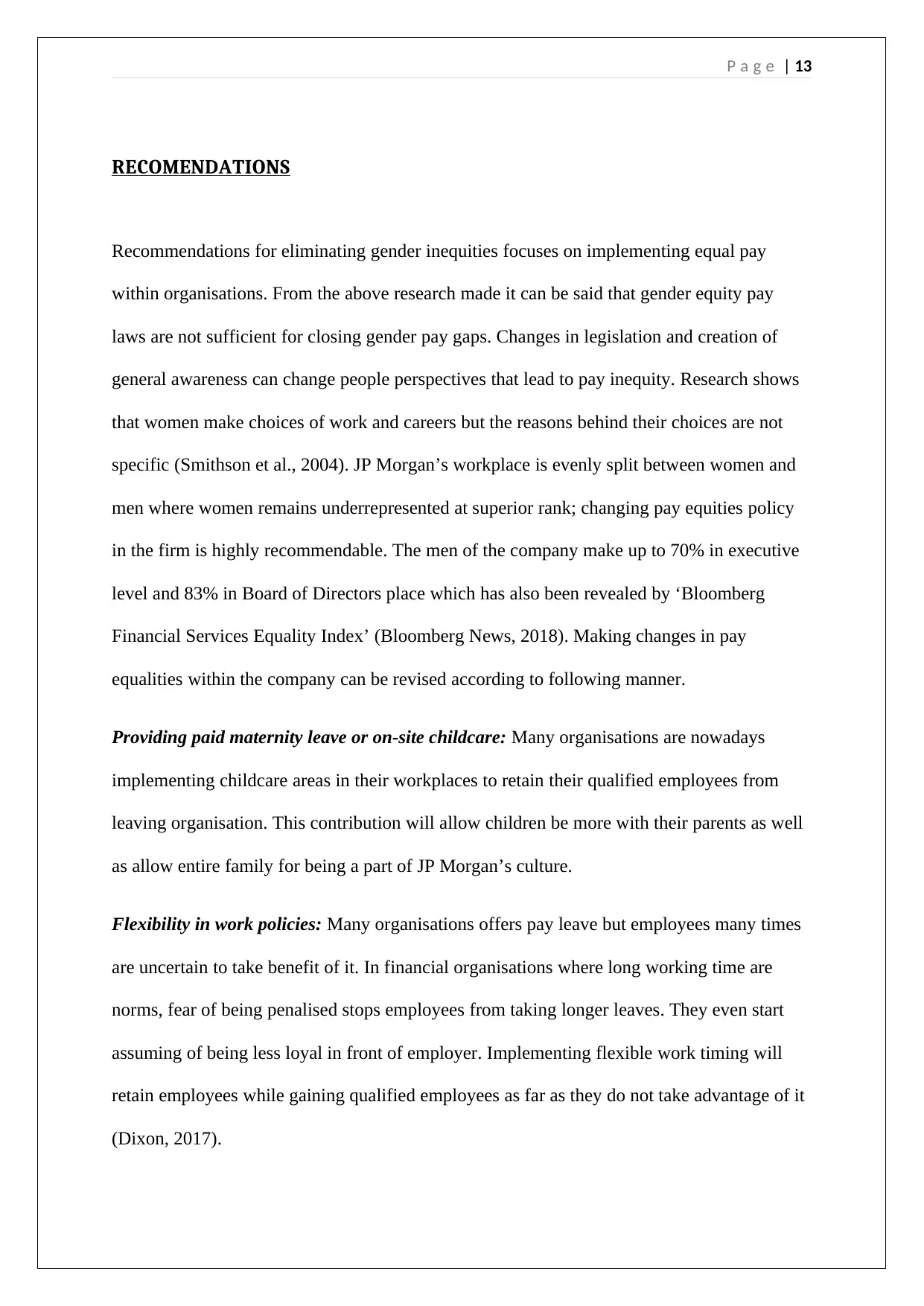
P a g e | 13
RECOMENDATIONS
Recommendations for eliminating gender inequities focuses on implementing equal pay
within organisations. From the above research made it can be said that gender equity pay
laws are not sufficient for closing gender pay gaps. Changes in legislation and creation of
general awareness can change people perspectives that lead to pay inequity. Research shows
that women make choices of work and careers but the reasons behind their choices are not
specific (Smithson et al., 2004). JP Morgan’s workplace is evenly split between women and
men where women remains underrepresented at superior rank; changing pay equities policy
in the firm is highly recommendable. The men of the company make up to 70% in executive
level and 83% in Board of Directors place which has also been revealed by ‘Bloomberg
Financial Services Equality Index’ (Bloomberg News, 2018). Making changes in pay
equalities within the company can be revised according to following manner.
Providing paid maternity leave or on-site childcare: Many organisations are nowadays
implementing childcare areas in their workplaces to retain their qualified employees from
leaving organisation. This contribution will allow children be more with their parents as well
as allow entire family for being a part of JP Morgan’s culture.
Flexibility in work policies: Many organisations offers pay leave but employees many times
are uncertain to take benefit of it. In financial organisations where long working time are
norms, fear of being penalised stops employees from taking longer leaves. They even start
assuming of being less loyal in front of employer. Implementing flexible work timing will
retain employees while gaining qualified employees as far as they do not take advantage of it
(Dixon, 2017).
RECOMENDATIONS
Recommendations for eliminating gender inequities focuses on implementing equal pay
within organisations. From the above research made it can be said that gender equity pay
laws are not sufficient for closing gender pay gaps. Changes in legislation and creation of
general awareness can change people perspectives that lead to pay inequity. Research shows
that women make choices of work and careers but the reasons behind their choices are not
specific (Smithson et al., 2004). JP Morgan’s workplace is evenly split between women and
men where women remains underrepresented at superior rank; changing pay equities policy
in the firm is highly recommendable. The men of the company make up to 70% in executive
level and 83% in Board of Directors place which has also been revealed by ‘Bloomberg
Financial Services Equality Index’ (Bloomberg News, 2018). Making changes in pay
equalities within the company can be revised according to following manner.
Providing paid maternity leave or on-site childcare: Many organisations are nowadays
implementing childcare areas in their workplaces to retain their qualified employees from
leaving organisation. This contribution will allow children be more with their parents as well
as allow entire family for being a part of JP Morgan’s culture.
Flexibility in work policies: Many organisations offers pay leave but employees many times
are uncertain to take benefit of it. In financial organisations where long working time are
norms, fear of being penalised stops employees from taking longer leaves. They even start
assuming of being less loyal in front of employer. Implementing flexible work timing will
retain employees while gaining qualified employees as far as they do not take advantage of it
(Dixon, 2017).
Paraphrase This Document
Need a fresh take? Get an instant paraphrase of this document with our AI Paraphraser
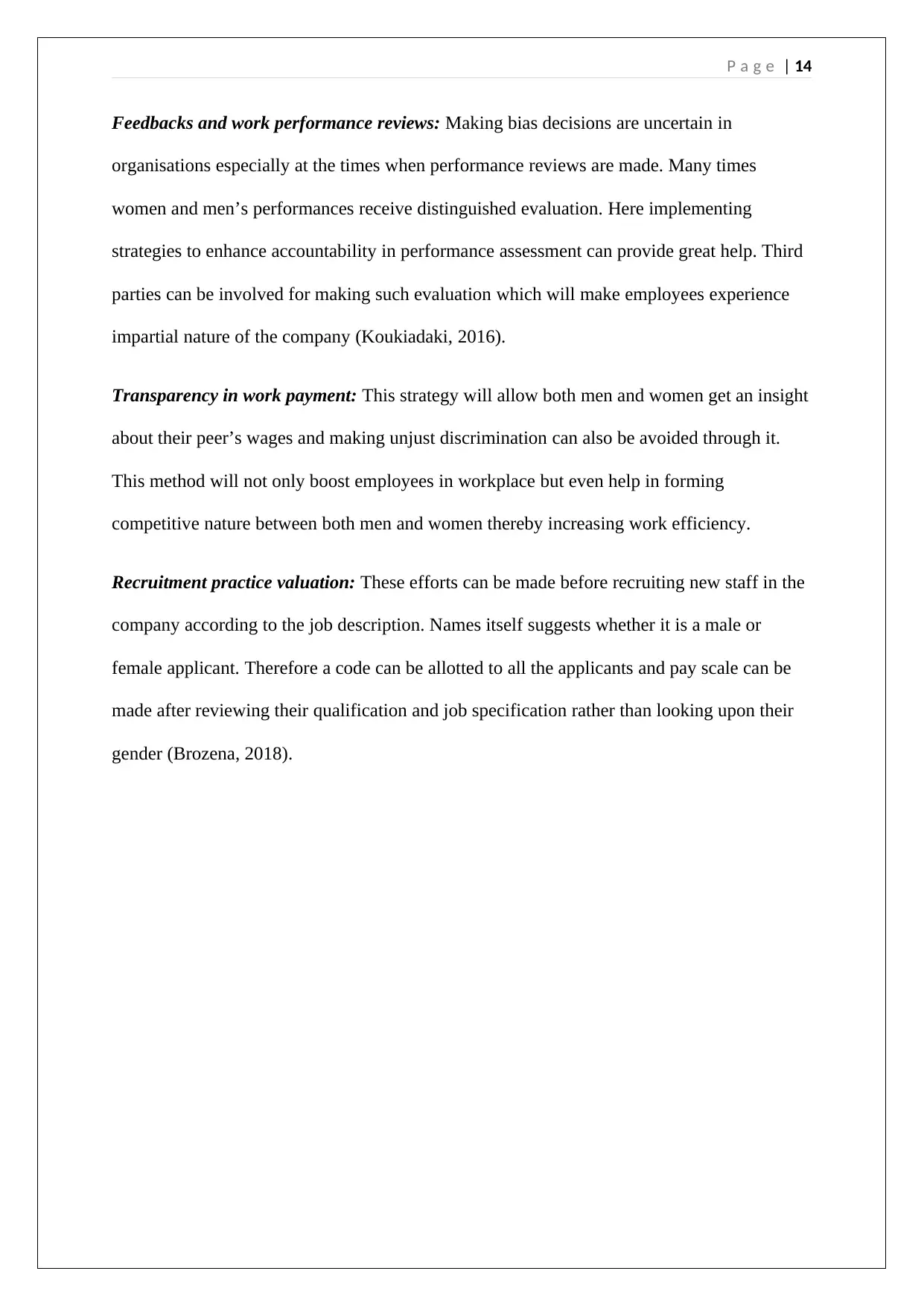
P a g e | 14
Feedbacks and work performance reviews: Making bias decisions are uncertain in
organisations especially at the times when performance reviews are made. Many times
women and men’s performances receive distinguished evaluation. Here implementing
strategies to enhance accountability in performance assessment can provide great help. Third
parties can be involved for making such evaluation which will make employees experience
impartial nature of the company (Koukiadaki, 2016).
Transparency in work payment: This strategy will allow both men and women get an insight
about their peer’s wages and making unjust discrimination can also be avoided through it.
This method will not only boost employees in workplace but even help in forming
competitive nature between both men and women thereby increasing work efficiency.
Recruitment practice valuation: These efforts can be made before recruiting new staff in the
company according to the job description. Names itself suggests whether it is a male or
female applicant. Therefore a code can be allotted to all the applicants and pay scale can be
made after reviewing their qualification and job specification rather than looking upon their
gender (Brozena, 2018).
Feedbacks and work performance reviews: Making bias decisions are uncertain in
organisations especially at the times when performance reviews are made. Many times
women and men’s performances receive distinguished evaluation. Here implementing
strategies to enhance accountability in performance assessment can provide great help. Third
parties can be involved for making such evaluation which will make employees experience
impartial nature of the company (Koukiadaki, 2016).
Transparency in work payment: This strategy will allow both men and women get an insight
about their peer’s wages and making unjust discrimination can also be avoided through it.
This method will not only boost employees in workplace but even help in forming
competitive nature between both men and women thereby increasing work efficiency.
Recruitment practice valuation: These efforts can be made before recruiting new staff in the
company according to the job description. Names itself suggests whether it is a male or
female applicant. Therefore a code can be allotted to all the applicants and pay scale can be
made after reviewing their qualification and job specification rather than looking upon their
gender (Brozena, 2018).
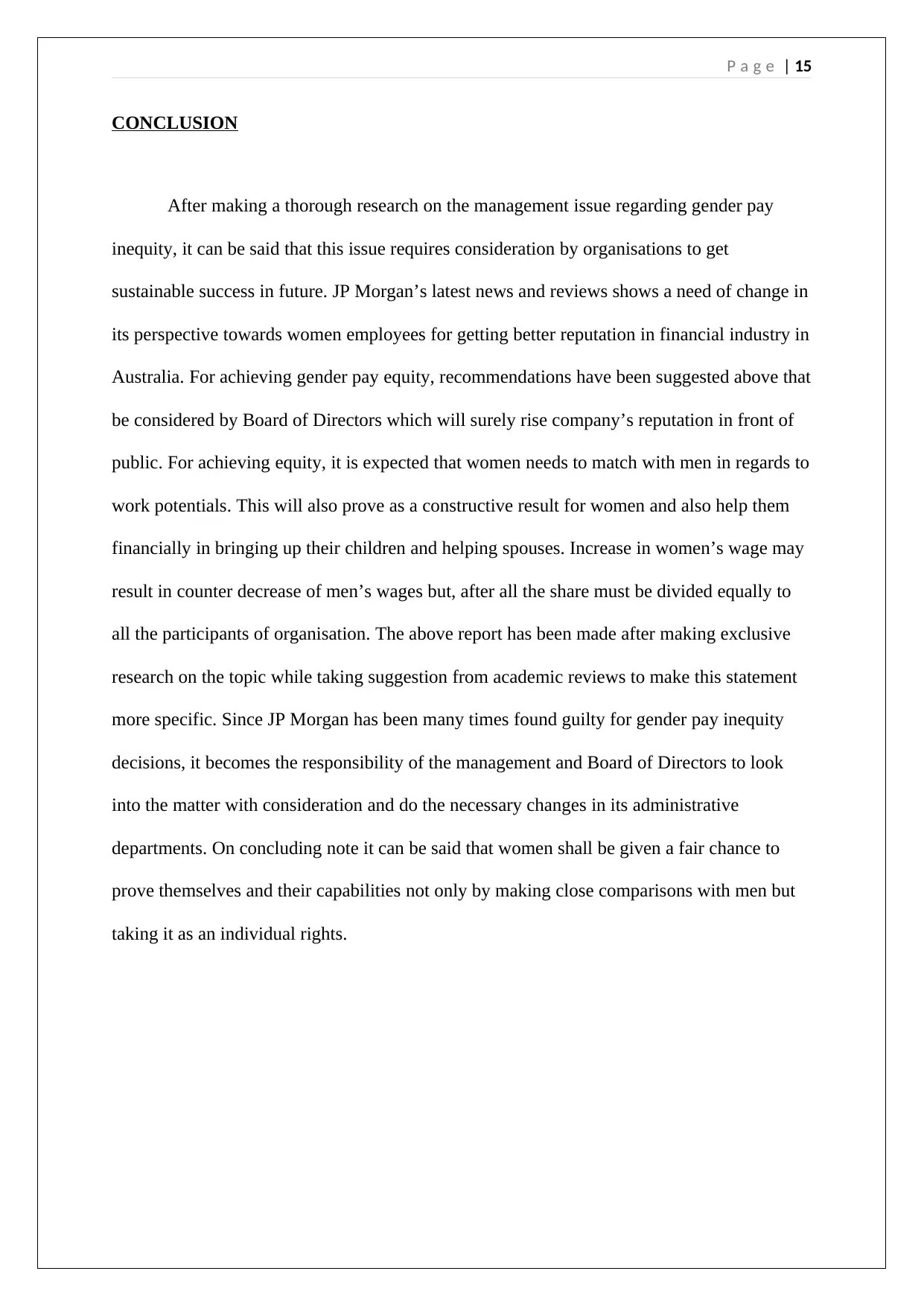
P a g e | 15
CONCLUSION
After making a thorough research on the management issue regarding gender pay
inequity, it can be said that this issue requires consideration by organisations to get
sustainable success in future. JP Morgan’s latest news and reviews shows a need of change in
its perspective towards women employees for getting better reputation in financial industry in
Australia. For achieving gender pay equity, recommendations have been suggested above that
be considered by Board of Directors which will surely rise company’s reputation in front of
public. For achieving equity, it is expected that women needs to match with men in regards to
work potentials. This will also prove as a constructive result for women and also help them
financially in bringing up their children and helping spouses. Increase in women’s wage may
result in counter decrease of men’s wages but, after all the share must be divided equally to
all the participants of organisation. The above report has been made after making exclusive
research on the topic while taking suggestion from academic reviews to make this statement
more specific. Since JP Morgan has been many times found guilty for gender pay inequity
decisions, it becomes the responsibility of the management and Board of Directors to look
into the matter with consideration and do the necessary changes in its administrative
departments. On concluding note it can be said that women shall be given a fair chance to
prove themselves and their capabilities not only by making close comparisons with men but
taking it as an individual rights.
CONCLUSION
After making a thorough research on the management issue regarding gender pay
inequity, it can be said that this issue requires consideration by organisations to get
sustainable success in future. JP Morgan’s latest news and reviews shows a need of change in
its perspective towards women employees for getting better reputation in financial industry in
Australia. For achieving gender pay equity, recommendations have been suggested above that
be considered by Board of Directors which will surely rise company’s reputation in front of
public. For achieving equity, it is expected that women needs to match with men in regards to
work potentials. This will also prove as a constructive result for women and also help them
financially in bringing up their children and helping spouses. Increase in women’s wage may
result in counter decrease of men’s wages but, after all the share must be divided equally to
all the participants of organisation. The above report has been made after making exclusive
research on the topic while taking suggestion from academic reviews to make this statement
more specific. Since JP Morgan has been many times found guilty for gender pay inequity
decisions, it becomes the responsibility of the management and Board of Directors to look
into the matter with consideration and do the necessary changes in its administrative
departments. On concluding note it can be said that women shall be given a fair chance to
prove themselves and their capabilities not only by making close comparisons with men but
taking it as an individual rights.
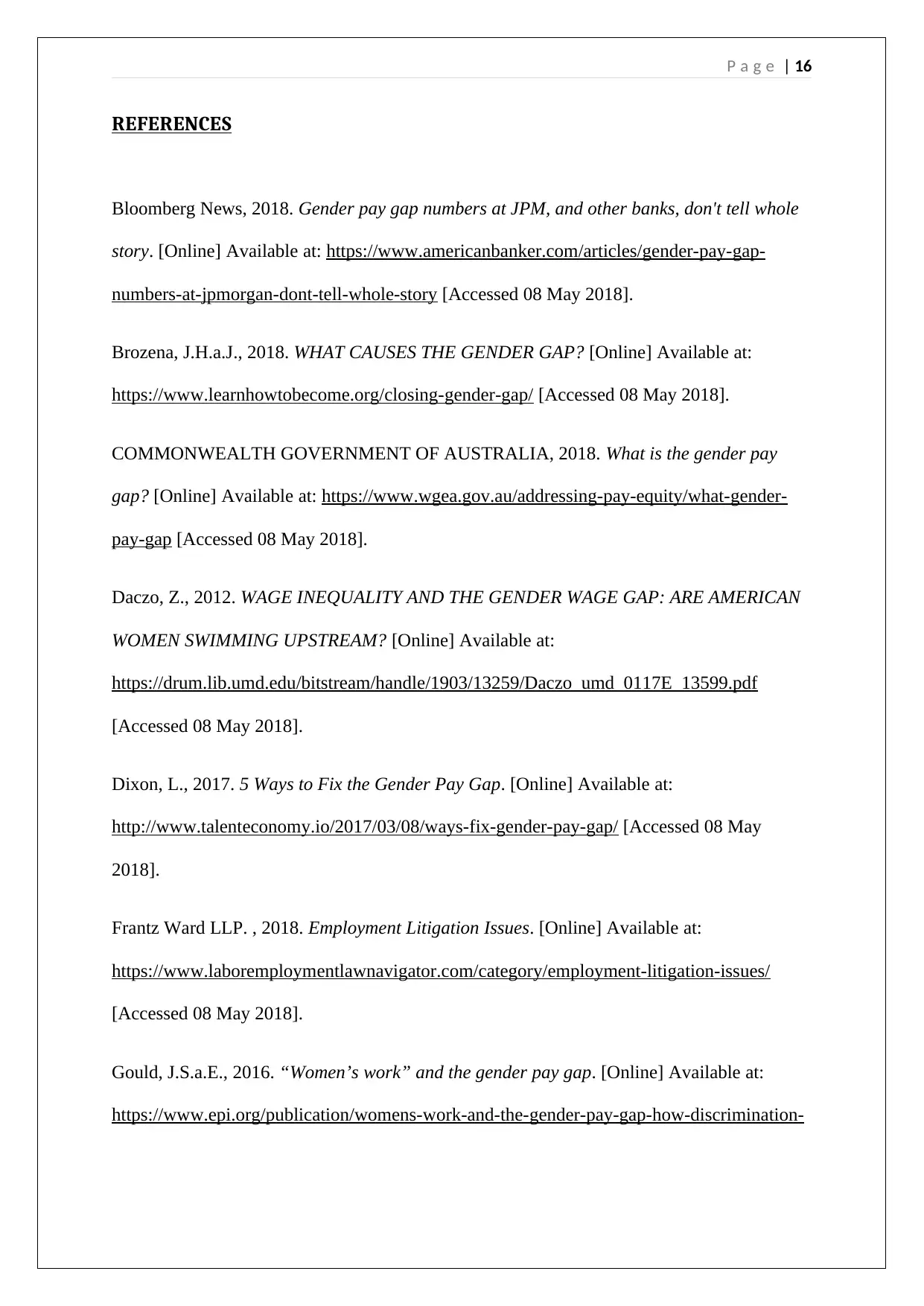
P a g e | 16
REFERENCES
Bloomberg News, 2018. Gender pay gap numbers at JPM, and other banks, don't tell whole
story. [Online] Available at: https://www.americanbanker.com/articles/gender-pay-gap-
numbers-at-jpmorgan-dont-tell-whole-story [Accessed 08 May 2018].
Brozena, J.H.a.J., 2018. WHAT CAUSES THE GENDER GAP? [Online] Available at:
https://www.learnhowtobecome.org/closing-gender-gap/ [Accessed 08 May 2018].
COMMONWEALTH GOVERNMENT OF AUSTRALIA, 2018. What is the gender pay
gap? [Online] Available at: https://www.wgea.gov.au/addressing-pay-equity/what-gender-
pay-gap [Accessed 08 May 2018].
Daczo, Z., 2012. WAGE INEQUALITY AND THE GENDER WAGE GAP: ARE AMERICAN
WOMEN SWIMMING UPSTREAM? [Online] Available at:
https://drum.lib.umd.edu/bitstream/handle/1903/13259/Daczo_umd_0117E_13599.pdf
[Accessed 08 May 2018].
Dixon, L., 2017. 5 Ways to Fix the Gender Pay Gap. [Online] Available at:
http://www.talenteconomy.io/2017/03/08/ways-fix-gender-pay-gap/ [Accessed 08 May
2018].
Frantz Ward LLP. , 2018. Employment Litigation Issues. [Online] Available at:
https://www.laboremploymentlawnavigator.com/category/employment-litigation-issues/
[Accessed 08 May 2018].
Gould, J.S.a.E., 2016. “Women’s work” and the gender pay gap. [Online] Available at:
https://www.epi.org/publication/womens-work-and-the-gender-pay-gap-how-discrimination-
REFERENCES
Bloomberg News, 2018. Gender pay gap numbers at JPM, and other banks, don't tell whole
story. [Online] Available at: https://www.americanbanker.com/articles/gender-pay-gap-
numbers-at-jpmorgan-dont-tell-whole-story [Accessed 08 May 2018].
Brozena, J.H.a.J., 2018. WHAT CAUSES THE GENDER GAP? [Online] Available at:
https://www.learnhowtobecome.org/closing-gender-gap/ [Accessed 08 May 2018].
COMMONWEALTH GOVERNMENT OF AUSTRALIA, 2018. What is the gender pay
gap? [Online] Available at: https://www.wgea.gov.au/addressing-pay-equity/what-gender-
pay-gap [Accessed 08 May 2018].
Daczo, Z., 2012. WAGE INEQUALITY AND THE GENDER WAGE GAP: ARE AMERICAN
WOMEN SWIMMING UPSTREAM? [Online] Available at:
https://drum.lib.umd.edu/bitstream/handle/1903/13259/Daczo_umd_0117E_13599.pdf
[Accessed 08 May 2018].
Dixon, L., 2017. 5 Ways to Fix the Gender Pay Gap. [Online] Available at:
http://www.talenteconomy.io/2017/03/08/ways-fix-gender-pay-gap/ [Accessed 08 May
2018].
Frantz Ward LLP. , 2018. Employment Litigation Issues. [Online] Available at:
https://www.laboremploymentlawnavigator.com/category/employment-litigation-issues/
[Accessed 08 May 2018].
Gould, J.S.a.E., 2016. “Women’s work” and the gender pay gap. [Online] Available at:
https://www.epi.org/publication/womens-work-and-the-gender-pay-gap-how-discrimination-
Secure Best Marks with AI Grader
Need help grading? Try our AI Grader for instant feedback on your assignments.
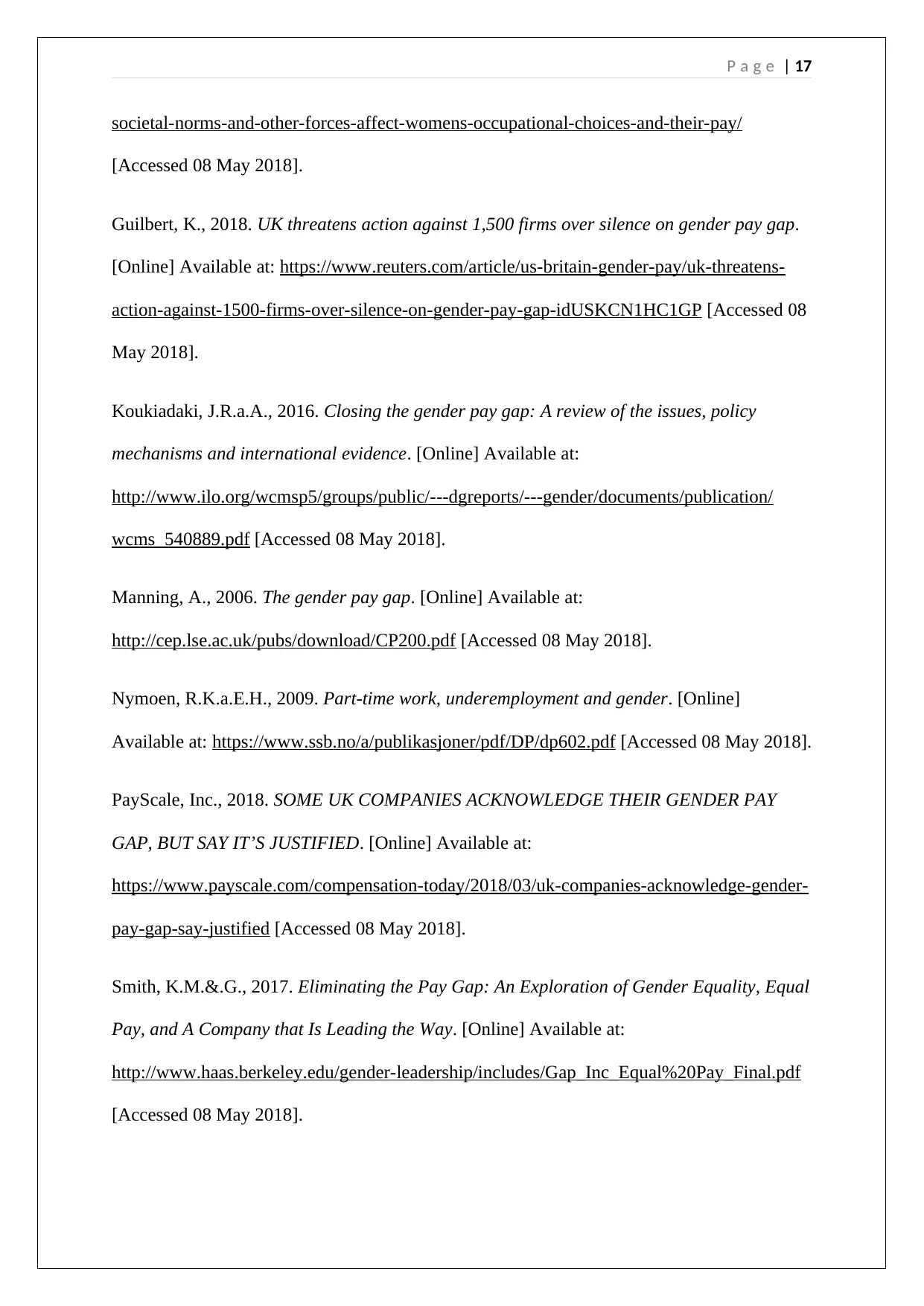
P a g e | 17
societal-norms-and-other-forces-affect-womens-occupational-choices-and-their-pay/
[Accessed 08 May 2018].
Guilbert, K., 2018. UK threatens action against 1,500 firms over silence on gender pay gap.
[Online] Available at: https://www.reuters.com/article/us-britain-gender-pay/uk-threatens-
action-against-1500-firms-over-silence-on-gender-pay-gap-idUSKCN1HC1GP [Accessed 08
May 2018].
Koukiadaki, J.R.a.A., 2016. Closing the gender pay gap: A review of the issues, policy
mechanisms and international evidence. [Online] Available at:
http://www.ilo.org/wcmsp5/groups/public/---dgreports/---gender/documents/publication/
wcms_540889.pdf [Accessed 08 May 2018].
Manning, A., 2006. The gender pay gap. [Online] Available at:
http://cep.lse.ac.uk/pubs/download/CP200.pdf [Accessed 08 May 2018].
Nymoen, R.K.a.E.H., 2009. Part-time work, underemployment and gender. [Online]
Available at: https://www.ssb.no/a/publikasjoner/pdf/DP/dp602.pdf [Accessed 08 May 2018].
PayScale, Inc., 2018. SOME UK COMPANIES ACKNOWLEDGE THEIR GENDER PAY
GAP, BUT SAY IT’S JUSTIFIED. [Online] Available at:
https://www.payscale.com/compensation-today/2018/03/uk-companies-acknowledge-gender-
pay-gap-say-justified [Accessed 08 May 2018].
Smith, K.M.&.G., 2017. Eliminating the Pay Gap: An Exploration of Gender Equality, Equal
Pay, and A Company that Is Leading the Way. [Online] Available at:
http://www.haas.berkeley.edu/gender-leadership/includes/Gap_Inc_Equal%20Pay_Final.pdf
[Accessed 08 May 2018].
societal-norms-and-other-forces-affect-womens-occupational-choices-and-their-pay/
[Accessed 08 May 2018].
Guilbert, K., 2018. UK threatens action against 1,500 firms over silence on gender pay gap.
[Online] Available at: https://www.reuters.com/article/us-britain-gender-pay/uk-threatens-
action-against-1500-firms-over-silence-on-gender-pay-gap-idUSKCN1HC1GP [Accessed 08
May 2018].
Koukiadaki, J.R.a.A., 2016. Closing the gender pay gap: A review of the issues, policy
mechanisms and international evidence. [Online] Available at:
http://www.ilo.org/wcmsp5/groups/public/---dgreports/---gender/documents/publication/
wcms_540889.pdf [Accessed 08 May 2018].
Manning, A., 2006. The gender pay gap. [Online] Available at:
http://cep.lse.ac.uk/pubs/download/CP200.pdf [Accessed 08 May 2018].
Nymoen, R.K.a.E.H., 2009. Part-time work, underemployment and gender. [Online]
Available at: https://www.ssb.no/a/publikasjoner/pdf/DP/dp602.pdf [Accessed 08 May 2018].
PayScale, Inc., 2018. SOME UK COMPANIES ACKNOWLEDGE THEIR GENDER PAY
GAP, BUT SAY IT’S JUSTIFIED. [Online] Available at:
https://www.payscale.com/compensation-today/2018/03/uk-companies-acknowledge-gender-
pay-gap-say-justified [Accessed 08 May 2018].
Smith, K.M.&.G., 2017. Eliminating the Pay Gap: An Exploration of Gender Equality, Equal
Pay, and A Company that Is Leading the Way. [Online] Available at:
http://www.haas.berkeley.edu/gender-leadership/includes/Gap_Inc_Equal%20Pay_Final.pdf
[Accessed 08 May 2018].
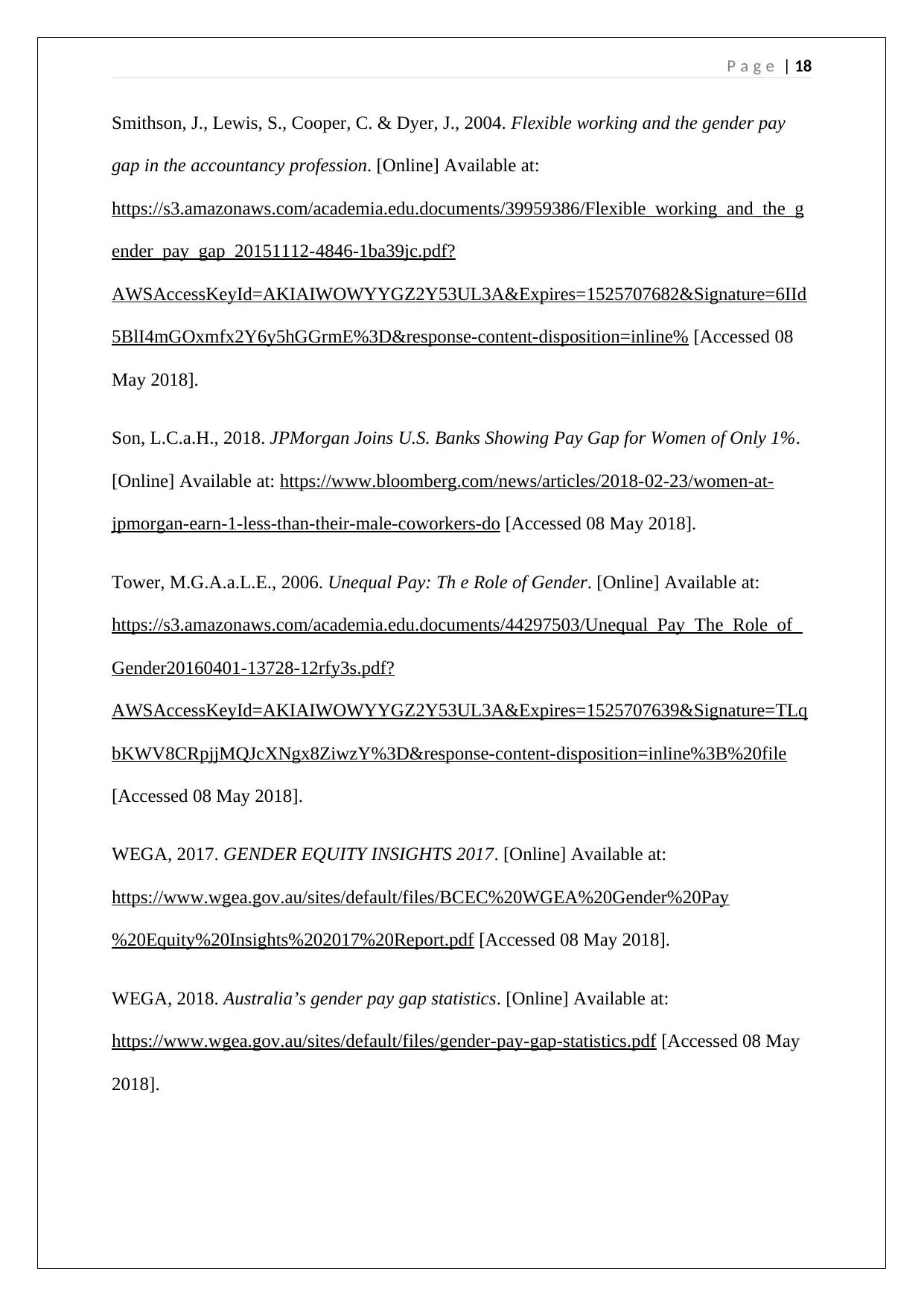
P a g e | 18
Smithson, J., Lewis, S., Cooper, C. & Dyer, J., 2004. Flexible working and the gender pay
gap in the accountancy profession. [Online] Available at:
https://s3.amazonaws.com/academia.edu.documents/39959386/Flexible_working_and_the_g
ender_pay_gap_20151112-4846-1ba39jc.pdf?
AWSAccessKeyId=AKIAIWOWYYGZ2Y53UL3A&Expires=1525707682&Signature=6IId
5BlI4mGOxmfx2Y6y5hGGrmE%3D&response-content-disposition=inline% [Accessed 08
May 2018].
Son, L.C.a.H., 2018. JPMorgan Joins U.S. Banks Showing Pay Gap for Women of Only 1%.
[Online] Available at: https://www.bloomberg.com/news/articles/2018-02-23/women-at-
jpmorgan-earn-1-less-than-their-male-coworkers-do [Accessed 08 May 2018].
Tower, M.G.A.a.L.E., 2006. Unequal Pay: Th e Role of Gender. [Online] Available at:
https://s3.amazonaws.com/academia.edu.documents/44297503/Unequal_Pay_The_Role_of_
Gender20160401-13728-12rfy3s.pdf?
AWSAccessKeyId=AKIAIWOWYYGZ2Y53UL3A&Expires=1525707639&Signature=TLq
bKWV8CRpjjMQJcXNgx8ZiwzY%3D&response-content-disposition=inline%3B%20file
[Accessed 08 May 2018].
WEGA, 2017. GENDER EQUITY INSIGHTS 2017. [Online] Available at:
https://www.wgea.gov.au/sites/default/files/BCEC%20WGEA%20Gender%20Pay
%20Equity%20Insights%202017%20Report.pdf [Accessed 08 May 2018].
WEGA, 2018. Australia’s gender pay gap statistics. [Online] Available at:
https://www.wgea.gov.au/sites/default/files/gender-pay-gap-statistics.pdf [Accessed 08 May
2018].
Smithson, J., Lewis, S., Cooper, C. & Dyer, J., 2004. Flexible working and the gender pay
gap in the accountancy profession. [Online] Available at:
https://s3.amazonaws.com/academia.edu.documents/39959386/Flexible_working_and_the_g
ender_pay_gap_20151112-4846-1ba39jc.pdf?
AWSAccessKeyId=AKIAIWOWYYGZ2Y53UL3A&Expires=1525707682&Signature=6IId
5BlI4mGOxmfx2Y6y5hGGrmE%3D&response-content-disposition=inline% [Accessed 08
May 2018].
Son, L.C.a.H., 2018. JPMorgan Joins U.S. Banks Showing Pay Gap for Women of Only 1%.
[Online] Available at: https://www.bloomberg.com/news/articles/2018-02-23/women-at-
jpmorgan-earn-1-less-than-their-male-coworkers-do [Accessed 08 May 2018].
Tower, M.G.A.a.L.E., 2006. Unequal Pay: Th e Role of Gender. [Online] Available at:
https://s3.amazonaws.com/academia.edu.documents/44297503/Unequal_Pay_The_Role_of_
Gender20160401-13728-12rfy3s.pdf?
AWSAccessKeyId=AKIAIWOWYYGZ2Y53UL3A&Expires=1525707639&Signature=TLq
bKWV8CRpjjMQJcXNgx8ZiwzY%3D&response-content-disposition=inline%3B%20file
[Accessed 08 May 2018].
WEGA, 2017. GENDER EQUITY INSIGHTS 2017. [Online] Available at:
https://www.wgea.gov.au/sites/default/files/BCEC%20WGEA%20Gender%20Pay
%20Equity%20Insights%202017%20Report.pdf [Accessed 08 May 2018].
WEGA, 2018. Australia’s gender pay gap statistics. [Online] Available at:
https://www.wgea.gov.au/sites/default/files/gender-pay-gap-statistics.pdf [Accessed 08 May
2018].
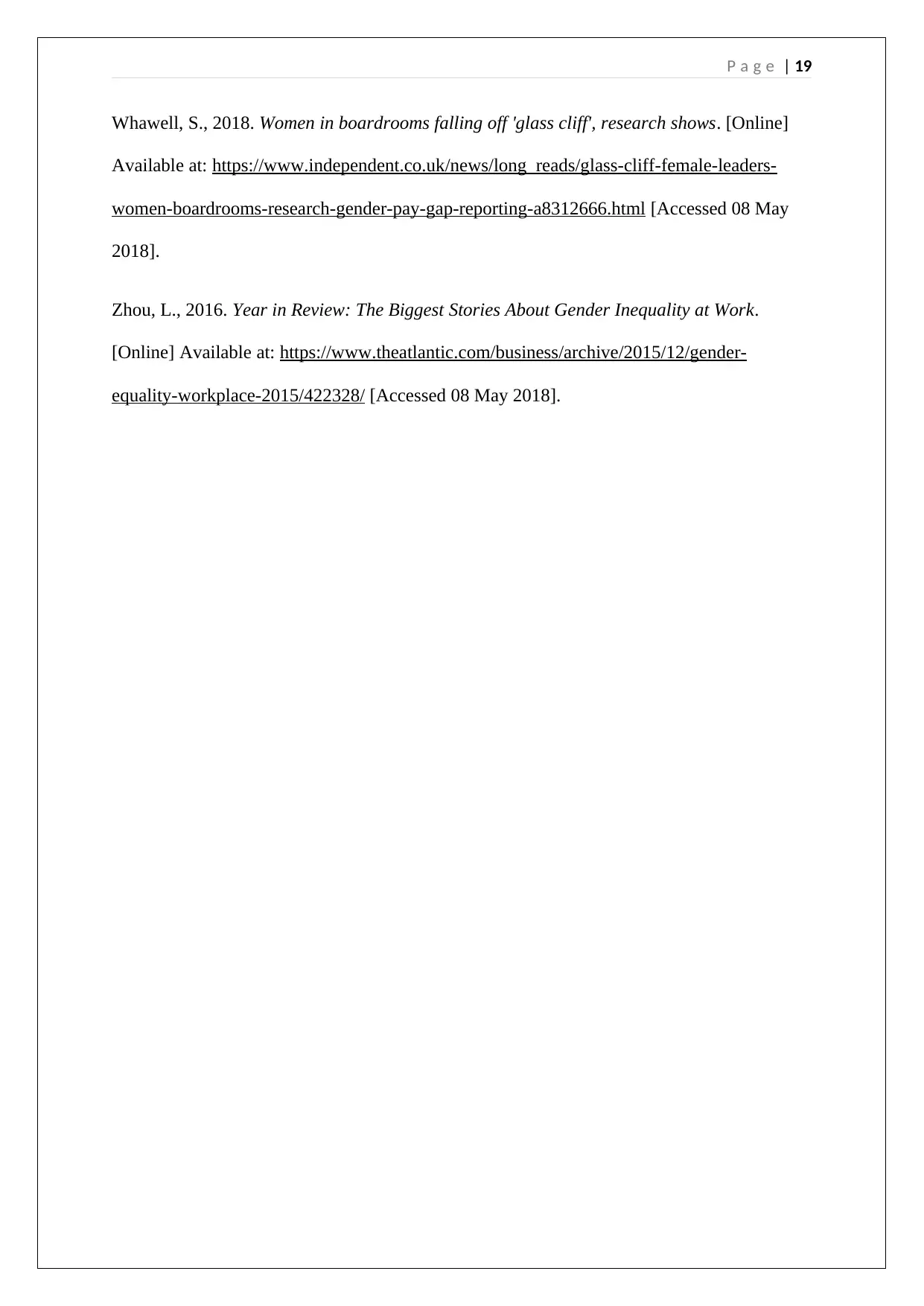
P a g e | 19
Whawell, S., 2018. Women in boardrooms falling off 'glass cliff', research shows. [Online]
Available at: https://www.independent.co.uk/news/long_reads/glass-cliff-female-leaders-
women-boardrooms-research-gender-pay-gap-reporting-a8312666.html [Accessed 08 May
2018].
Zhou, L., 2016. Year in Review: The Biggest Stories About Gender Inequality at Work.
[Online] Available at: https://www.theatlantic.com/business/archive/2015/12/gender-
equality-workplace-2015/422328/ [Accessed 08 May 2018].
Whawell, S., 2018. Women in boardrooms falling off 'glass cliff', research shows. [Online]
Available at: https://www.independent.co.uk/news/long_reads/glass-cliff-female-leaders-
women-boardrooms-research-gender-pay-gap-reporting-a8312666.html [Accessed 08 May
2018].
Zhou, L., 2016. Year in Review: The Biggest Stories About Gender Inequality at Work.
[Online] Available at: https://www.theatlantic.com/business/archive/2015/12/gender-
equality-workplace-2015/422328/ [Accessed 08 May 2018].
1 out of 19
Related Documents
Your All-in-One AI-Powered Toolkit for Academic Success.
+13062052269
info@desklib.com
Available 24*7 on WhatsApp / Email
![[object Object]](/_next/static/media/star-bottom.7253800d.svg)
Unlock your academic potential
© 2024 | Zucol Services PVT LTD | All rights reserved.





